Strategic Management: The Consultancy Merger Case Analysis 2018
VerifiedAdded on 2023/05/28
|18
|5848
|433
Case Study
AI Summary
This case study provides a strategic analysis of a consultancy merger, examining the integration of IT Con and Man Con from classical and systematic perspectives. The merger aimed to enhance geographical presence and business complementarity. The study explores the initial positive reactions, the challenges arising from differing business logics and cultures, and the implementation of bureaucratic management theories. It further discusses the development of specialized business units and integrated offers, highlighting the tensions between internal focus and external client engagement. The analysis draws on theories of bureaucratic management to understand the dynamics and outcomes of the merger, ultimately reflecting on the integration process and its impact on organizational performance, with the document being available on Desklib for students seeking similar case studies and solved assignments.
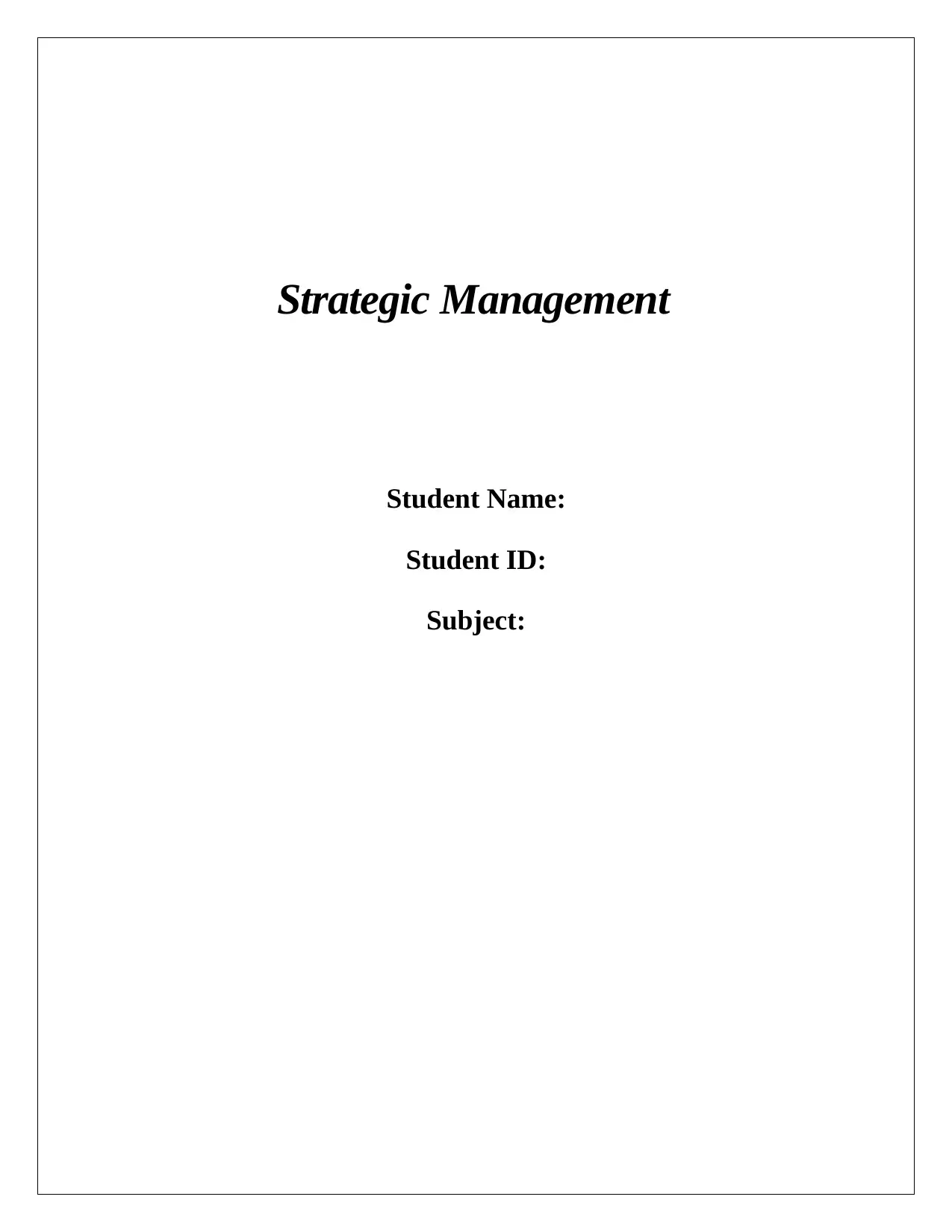
Strategic Management
Student Name:
Student ID:
Subject:
Student Name:
Student ID:
Subject:
Secure Best Marks with AI Grader
Need help grading? Try our AI Grader for instant feedback on your assignments.
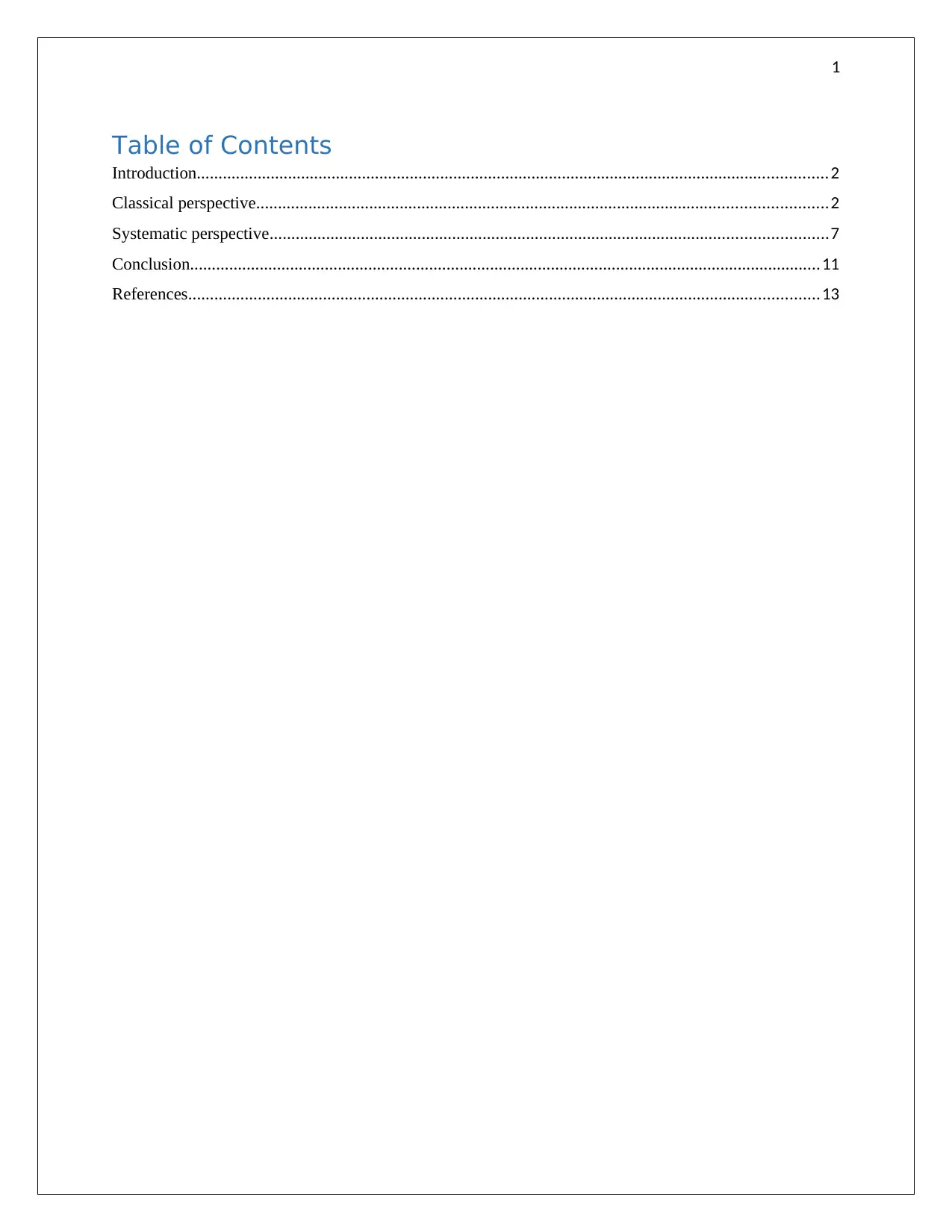
1
Table of Contents
Introduction.................................................................................................................................................2
Classical perspective...................................................................................................................................2
Systematic perspective................................................................................................................................7
Conclusion.................................................................................................................................................11
References.................................................................................................................................................13
Table of Contents
Introduction.................................................................................................................................................2
Classical perspective...................................................................................................................................2
Systematic perspective................................................................................................................................7
Conclusion.................................................................................................................................................11
References.................................................................................................................................................13
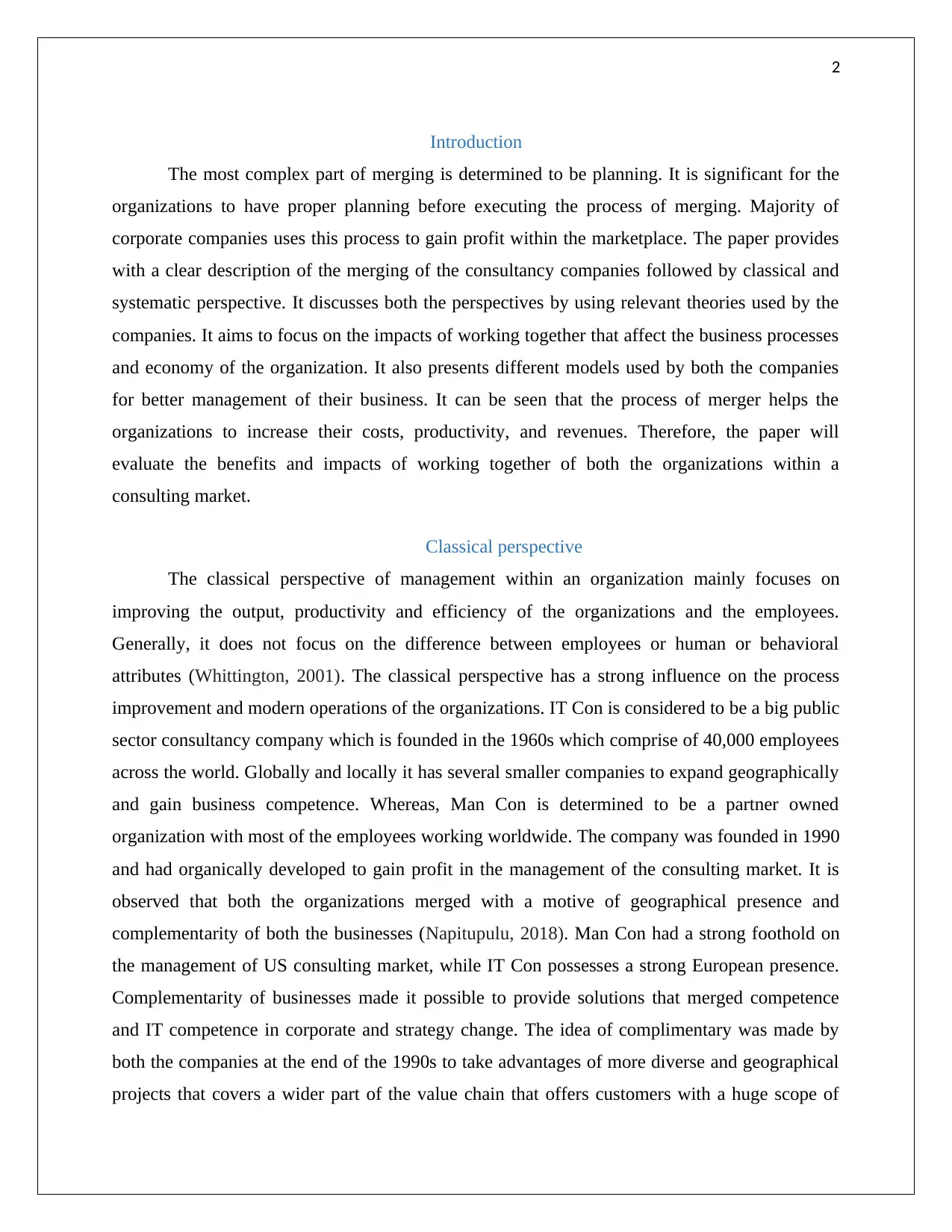
2
Introduction
The most complex part of merging is determined to be planning. It is significant for the
organizations to have proper planning before executing the process of merging. Majority of
corporate companies uses this process to gain profit within the marketplace. The paper provides
with a clear description of the merging of the consultancy companies followed by classical and
systematic perspective. It discusses both the perspectives by using relevant theories used by the
companies. It aims to focus on the impacts of working together that affect the business processes
and economy of the organization. It also presents different models used by both the companies
for better management of their business. It can be seen that the process of merger helps the
organizations to increase their costs, productivity, and revenues. Therefore, the paper will
evaluate the benefits and impacts of working together of both the organizations within a
consulting market.
Classical perspective
The classical perspective of management within an organization mainly focuses on
improving the output, productivity and efficiency of the organizations and the employees.
Generally, it does not focus on the difference between employees or human or behavioral
attributes (Whittington, 2001). The classical perspective has a strong influence on the process
improvement and modern operations of the organizations. IT Con is considered to be a big public
sector consultancy company which is founded in the 1960s which comprise of 40,000 employees
across the world. Globally and locally it has several smaller companies to expand geographically
and gain business competence. Whereas, Man Con is determined to be a partner owned
organization with most of the employees working worldwide. The company was founded in 1990
and had organically developed to gain profit in the management of the consulting market. It is
observed that both the organizations merged with a motive of geographical presence and
complementarity of both the businesses (Napitupulu, 2018). Man Con had a strong foothold on
the management of US consulting market, while IT Con possesses a strong European presence.
Complementarity of businesses made it possible to provide solutions that merged competence
and IT competence in corporate and strategy change. The idea of complimentary was made by
both the companies at the end of the 1990s to take advantages of more diverse and geographical
projects that covers a wider part of the value chain that offers customers with a huge scope of
Introduction
The most complex part of merging is determined to be planning. It is significant for the
organizations to have proper planning before executing the process of merging. Majority of
corporate companies uses this process to gain profit within the marketplace. The paper provides
with a clear description of the merging of the consultancy companies followed by classical and
systematic perspective. It discusses both the perspectives by using relevant theories used by the
companies. It aims to focus on the impacts of working together that affect the business processes
and economy of the organization. It also presents different models used by both the companies
for better management of their business. It can be seen that the process of merger helps the
organizations to increase their costs, productivity, and revenues. Therefore, the paper will
evaluate the benefits and impacts of working together of both the organizations within a
consulting market.
Classical perspective
The classical perspective of management within an organization mainly focuses on
improving the output, productivity and efficiency of the organizations and the employees.
Generally, it does not focus on the difference between employees or human or behavioral
attributes (Whittington, 2001). The classical perspective has a strong influence on the process
improvement and modern operations of the organizations. IT Con is considered to be a big public
sector consultancy company which is founded in the 1960s which comprise of 40,000 employees
across the world. Globally and locally it has several smaller companies to expand geographically
and gain business competence. Whereas, Man Con is determined to be a partner owned
organization with most of the employees working worldwide. The company was founded in 1990
and had organically developed to gain profit in the management of the consulting market. It is
observed that both the organizations merged with a motive of geographical presence and
complementarity of both the businesses (Napitupulu, 2018). Man Con had a strong foothold on
the management of US consulting market, while IT Con possesses a strong European presence.
Complementarity of businesses made it possible to provide solutions that merged competence
and IT competence in corporate and strategy change. The idea of complimentary was made by
both the companies at the end of the 1990s to take advantages of more diverse and geographical
projects that covers a wider part of the value chain that offers customers with a huge scope of
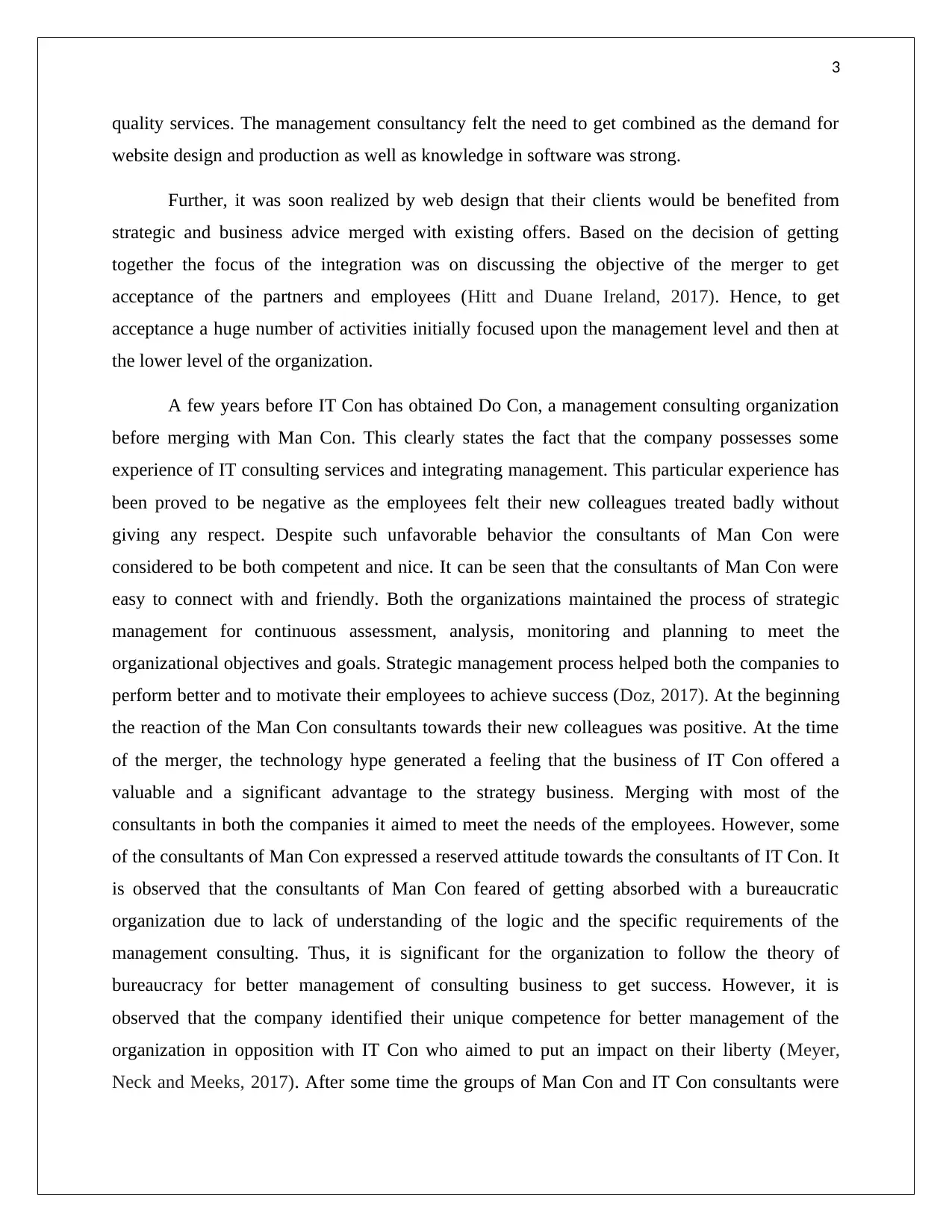
3
quality services. The management consultancy felt the need to get combined as the demand for
website design and production as well as knowledge in software was strong.
Further, it was soon realized by web design that their clients would be benefited from
strategic and business advice merged with existing offers. Based on the decision of getting
together the focus of the integration was on discussing the objective of the merger to get
acceptance of the partners and employees (Hitt and Duane Ireland, 2017). Hence, to get
acceptance a huge number of activities initially focused upon the management level and then at
the lower level of the organization.
A few years before IT Con has obtained Do Con, a management consulting organization
before merging with Man Con. This clearly states the fact that the company possesses some
experience of IT consulting services and integrating management. This particular experience has
been proved to be negative as the employees felt their new colleagues treated badly without
giving any respect. Despite such unfavorable behavior the consultants of Man Con were
considered to be both competent and nice. It can be seen that the consultants of Man Con were
easy to connect with and friendly. Both the organizations maintained the process of strategic
management for continuous assessment, analysis, monitoring and planning to meet the
organizational objectives and goals. Strategic management process helped both the companies to
perform better and to motivate their employees to achieve success (Doz, 2017). At the beginning
the reaction of the Man Con consultants towards their new colleagues was positive. At the time
of the merger, the technology hype generated a feeling that the business of IT Con offered a
valuable and a significant advantage to the strategy business. Merging with most of the
consultants in both the companies it aimed to meet the needs of the employees. However, some
of the consultants of Man Con expressed a reserved attitude towards the consultants of IT Con. It
is observed that the consultants of Man Con feared of getting absorbed with a bureaucratic
organization due to lack of understanding of the logic and the specific requirements of the
management consulting. Thus, it is significant for the organization to follow the theory of
bureaucracy for better management of consulting business to get success. However, it is
observed that the company identified their unique competence for better management of the
organization in opposition with IT Con who aimed to put an impact on their liberty (Meyer,
Neck and Meeks, 2017). After some time the groups of Man Con and IT Con consultants were
quality services. The management consultancy felt the need to get combined as the demand for
website design and production as well as knowledge in software was strong.
Further, it was soon realized by web design that their clients would be benefited from
strategic and business advice merged with existing offers. Based on the decision of getting
together the focus of the integration was on discussing the objective of the merger to get
acceptance of the partners and employees (Hitt and Duane Ireland, 2017). Hence, to get
acceptance a huge number of activities initially focused upon the management level and then at
the lower level of the organization.
A few years before IT Con has obtained Do Con, a management consulting organization
before merging with Man Con. This clearly states the fact that the company possesses some
experience of IT consulting services and integrating management. This particular experience has
been proved to be negative as the employees felt their new colleagues treated badly without
giving any respect. Despite such unfavorable behavior the consultants of Man Con were
considered to be both competent and nice. It can be seen that the consultants of Man Con were
easy to connect with and friendly. Both the organizations maintained the process of strategic
management for continuous assessment, analysis, monitoring and planning to meet the
organizational objectives and goals. Strategic management process helped both the companies to
perform better and to motivate their employees to achieve success (Doz, 2017). At the beginning
the reaction of the Man Con consultants towards their new colleagues was positive. At the time
of the merger, the technology hype generated a feeling that the business of IT Con offered a
valuable and a significant advantage to the strategy business. Merging with most of the
consultants in both the companies it aimed to meet the needs of the employees. However, some
of the consultants of Man Con expressed a reserved attitude towards the consultants of IT Con. It
is observed that the consultants of Man Con feared of getting absorbed with a bureaucratic
organization due to lack of understanding of the logic and the specific requirements of the
management consulting. Thus, it is significant for the organization to follow the theory of
bureaucracy for better management of consulting business to get success. However, it is
observed that the company identified their unique competence for better management of the
organization in opposition with IT Con who aimed to put an impact on their liberty (Meyer,
Neck and Meeks, 2017). After some time the groups of Man Con and IT Con consultants were
Secure Best Marks with AI Grader
Need help grading? Try our AI Grader for instant feedback on your assignments.
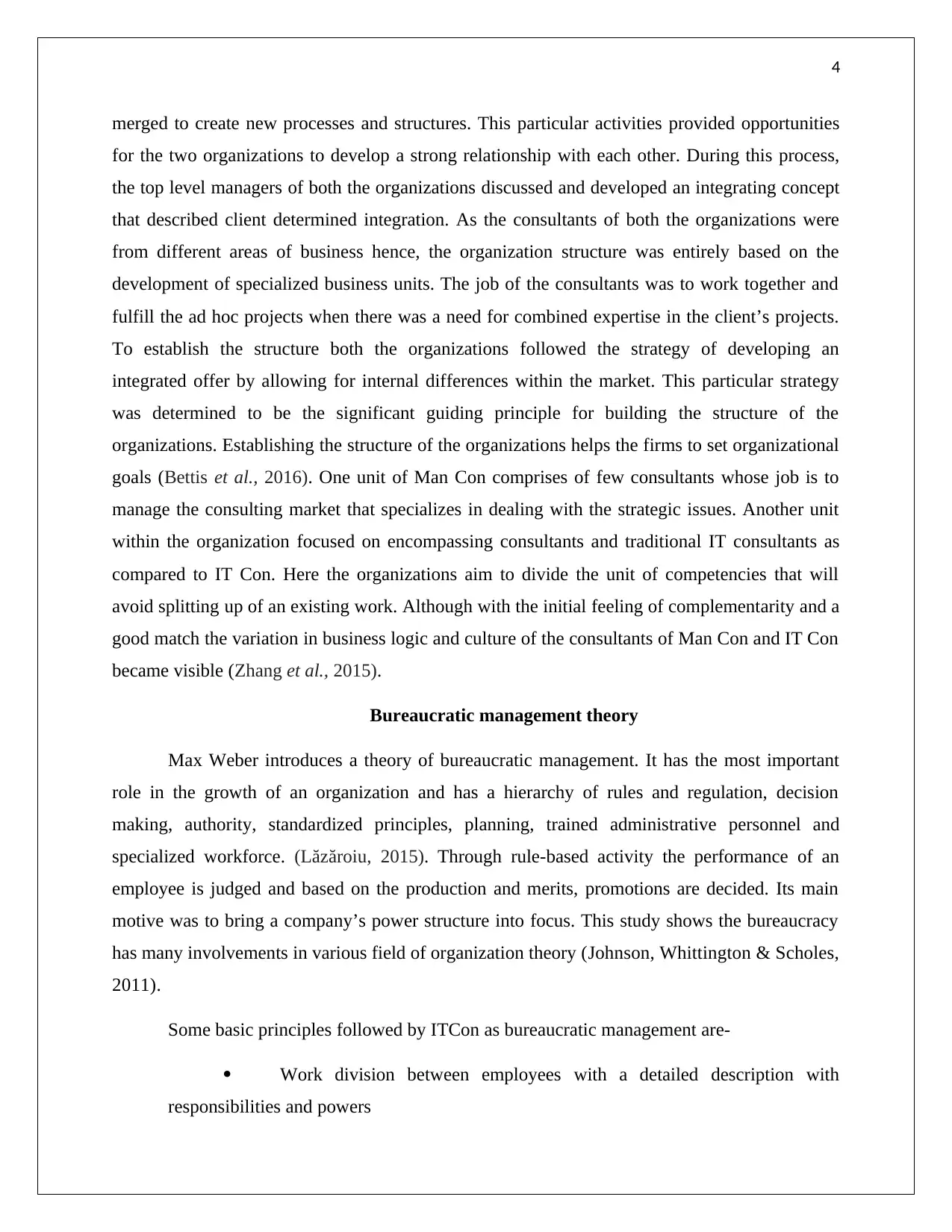
4
merged to create new processes and structures. This particular activities provided opportunities
for the two organizations to develop a strong relationship with each other. During this process,
the top level managers of both the organizations discussed and developed an integrating concept
that described client determined integration. As the consultants of both the organizations were
from different areas of business hence, the organization structure was entirely based on the
development of specialized business units. The job of the consultants was to work together and
fulfill the ad hoc projects when there was a need for combined expertise in the client’s projects.
To establish the structure both the organizations followed the strategy of developing an
integrated offer by allowing for internal differences within the market. This particular strategy
was determined to be the significant guiding principle for building the structure of the
organizations. Establishing the structure of the organizations helps the firms to set organizational
goals (Bettis et al., 2016). One unit of Man Con comprises of few consultants whose job is to
manage the consulting market that specializes in dealing with the strategic issues. Another unit
within the organization focused on encompassing consultants and traditional IT consultants as
compared to IT Con. Here the organizations aim to divide the unit of competencies that will
avoid splitting up of an existing work. Although with the initial feeling of complementarity and a
good match the variation in business logic and culture of the consultants of Man Con and IT Con
became visible (Zhang et al., 2015).
Bureaucratic management theory
Max Weber introduces a theory of bureaucratic management. It has the most important
role in the growth of an organization and has a hierarchy of rules and regulation, decision
making, authority, standardized principles, planning, trained administrative personnel and
specialized workforce. (Lăzăroiu, 2015). Through rule-based activity the performance of an
employee is judged and based on the production and merits, promotions are decided. Its main
motive was to bring a company’s power structure into focus. This study shows the bureaucracy
has many involvements in various field of organization theory (Johnson, Whittington & Scholes,
2011).
Some basic principles followed by ITCon as bureaucratic management are-
Work division between employees with a detailed description with
responsibilities and powers
merged to create new processes and structures. This particular activities provided opportunities
for the two organizations to develop a strong relationship with each other. During this process,
the top level managers of both the organizations discussed and developed an integrating concept
that described client determined integration. As the consultants of both the organizations were
from different areas of business hence, the organization structure was entirely based on the
development of specialized business units. The job of the consultants was to work together and
fulfill the ad hoc projects when there was a need for combined expertise in the client’s projects.
To establish the structure both the organizations followed the strategy of developing an
integrated offer by allowing for internal differences within the market. This particular strategy
was determined to be the significant guiding principle for building the structure of the
organizations. Establishing the structure of the organizations helps the firms to set organizational
goals (Bettis et al., 2016). One unit of Man Con comprises of few consultants whose job is to
manage the consulting market that specializes in dealing with the strategic issues. Another unit
within the organization focused on encompassing consultants and traditional IT consultants as
compared to IT Con. Here the organizations aim to divide the unit of competencies that will
avoid splitting up of an existing work. Although with the initial feeling of complementarity and a
good match the variation in business logic and culture of the consultants of Man Con and IT Con
became visible (Zhang et al., 2015).
Bureaucratic management theory
Max Weber introduces a theory of bureaucratic management. It has the most important
role in the growth of an organization and has a hierarchy of rules and regulation, decision
making, authority, standardized principles, planning, trained administrative personnel and
specialized workforce. (Lăzăroiu, 2015). Through rule-based activity the performance of an
employee is judged and based on the production and merits, promotions are decided. Its main
motive was to bring a company’s power structure into focus. This study shows the bureaucracy
has many involvements in various field of organization theory (Johnson, Whittington & Scholes,
2011).
Some basic principles followed by ITCon as bureaucratic management are-
Work division between employees with a detailed description with
responsibilities and powers
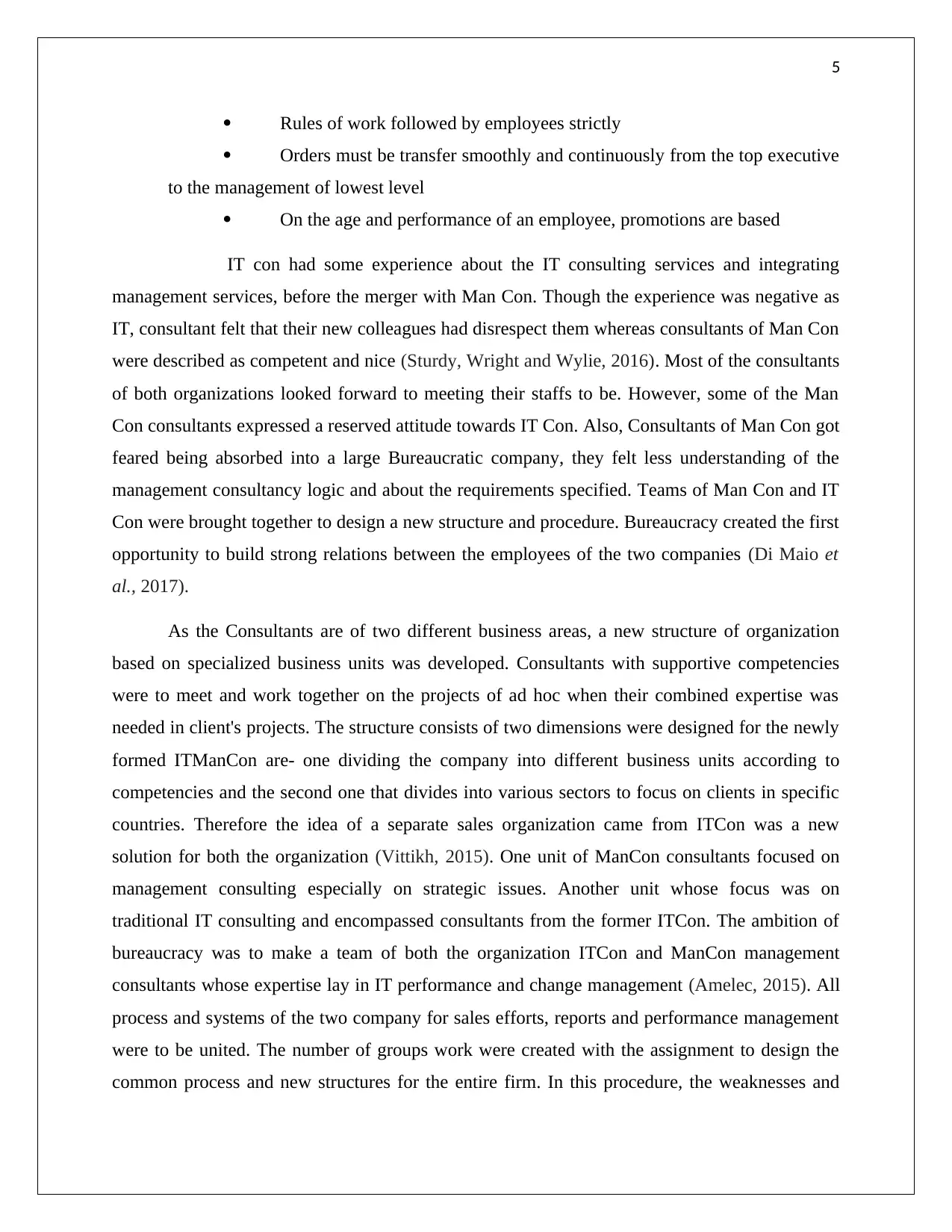
5
Rules of work followed by employees strictly
Orders must be transfer smoothly and continuously from the top executive
to the management of lowest level
On the age and performance of an employee, promotions are based
IT con had some experience about the IT consulting services and integrating
management services, before the merger with Man Con. Though the experience was negative as
IT, consultant felt that their new colleagues had disrespect them whereas consultants of Man Con
were described as competent and nice (Sturdy, Wright and Wylie, 2016). Most of the consultants
of both organizations looked forward to meeting their staffs to be. However, some of the Man
Con consultants expressed a reserved attitude towards IT Con. Also, Consultants of Man Con got
feared being absorbed into a large Bureaucratic company, they felt less understanding of the
management consultancy logic and about the requirements specified. Teams of Man Con and IT
Con were brought together to design a new structure and procedure. Bureaucracy created the first
opportunity to build strong relations between the employees of the two companies (Di Maio et
al., 2017).
As the Consultants are of two different business areas, a new structure of organization
based on specialized business units was developed. Consultants with supportive competencies
were to meet and work together on the projects of ad hoc when their combined expertise was
needed in client's projects. The structure consists of two dimensions were designed for the newly
formed ITManCon are- one dividing the company into different business units according to
competencies and the second one that divides into various sectors to focus on clients in specific
countries. Therefore the idea of a separate sales organization came from ITCon was a new
solution for both the organization (Vittikh, 2015). One unit of ManCon consultants focused on
management consulting especially on strategic issues. Another unit whose focus was on
traditional IT consulting and encompassed consultants from the former ITCon. The ambition of
bureaucracy was to make a team of both the organization ITCon and ManCon management
consultants whose expertise lay in IT performance and change management (Amelec, 2015). All
process and systems of the two company for sales efforts, reports and performance management
were to be united. The number of groups work were created with the assignment to design the
common process and new structures for the entire firm. In this procedure, the weaknesses and
Rules of work followed by employees strictly
Orders must be transfer smoothly and continuously from the top executive
to the management of lowest level
On the age and performance of an employee, promotions are based
IT con had some experience about the IT consulting services and integrating
management services, before the merger with Man Con. Though the experience was negative as
IT, consultant felt that their new colleagues had disrespect them whereas consultants of Man Con
were described as competent and nice (Sturdy, Wright and Wylie, 2016). Most of the consultants
of both organizations looked forward to meeting their staffs to be. However, some of the Man
Con consultants expressed a reserved attitude towards IT Con. Also, Consultants of Man Con got
feared being absorbed into a large Bureaucratic company, they felt less understanding of the
management consultancy logic and about the requirements specified. Teams of Man Con and IT
Con were brought together to design a new structure and procedure. Bureaucracy created the first
opportunity to build strong relations between the employees of the two companies (Di Maio et
al., 2017).
As the Consultants are of two different business areas, a new structure of organization
based on specialized business units was developed. Consultants with supportive competencies
were to meet and work together on the projects of ad hoc when their combined expertise was
needed in client's projects. The structure consists of two dimensions were designed for the newly
formed ITManCon are- one dividing the company into different business units according to
competencies and the second one that divides into various sectors to focus on clients in specific
countries. Therefore the idea of a separate sales organization came from ITCon was a new
solution for both the organization (Vittikh, 2015). One unit of ManCon consultants focused on
management consulting especially on strategic issues. Another unit whose focus was on
traditional IT consulting and encompassed consultants from the former ITCon. The ambition of
bureaucracy was to make a team of both the organization ITCon and ManCon management
consultants whose expertise lay in IT performance and change management (Amelec, 2015). All
process and systems of the two company for sales efforts, reports and performance management
were to be united. The number of groups work were created with the assignment to design the
common process and new structures for the entire firm. In this procedure, the weaknesses and
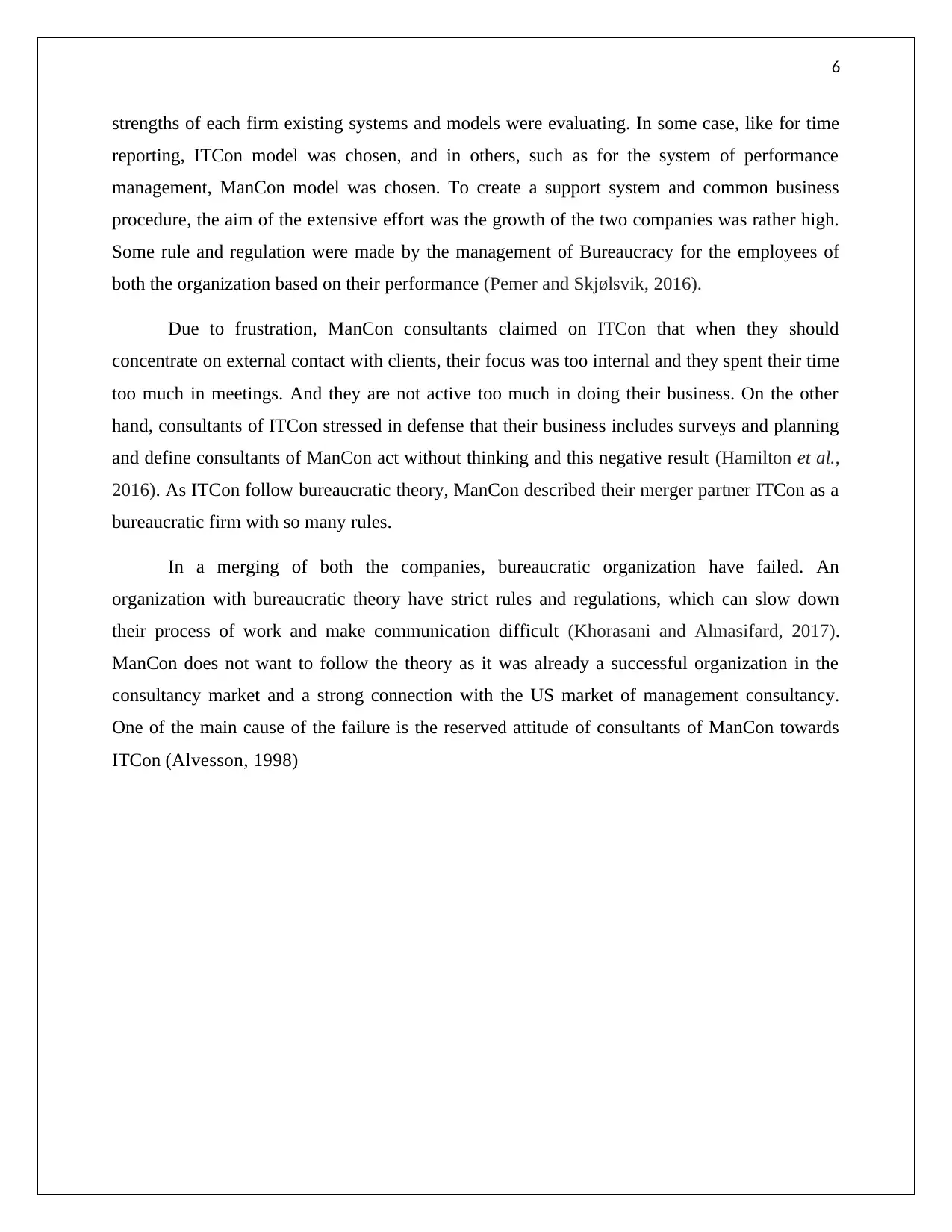
6
strengths of each firm existing systems and models were evaluating. In some case, like for time
reporting, ITCon model was chosen, and in others, such as for the system of performance
management, ManCon model was chosen. To create a support system and common business
procedure, the aim of the extensive effort was the growth of the two companies was rather high.
Some rule and regulation were made by the management of Bureaucracy for the employees of
both the organization based on their performance (Pemer and Skjølsvik, 2016).
Due to frustration, ManCon consultants claimed on ITCon that when they should
concentrate on external contact with clients, their focus was too internal and they spent their time
too much in meetings. And they are not active too much in doing their business. On the other
hand, consultants of ITCon stressed in defense that their business includes surveys and planning
and define consultants of ManCon act without thinking and this negative result (Hamilton et al.,
2016). As ITCon follow bureaucratic theory, ManCon described their merger partner ITCon as a
bureaucratic firm with so many rules.
In a merging of both the companies, bureaucratic organization have failed. An
organization with bureaucratic theory have strict rules and regulations, which can slow down
their process of work and make communication difficult (Khorasani and Almasifard, 2017).
ManCon does not want to follow the theory as it was already a successful organization in the
consultancy market and a strong connection with the US market of management consultancy.
One of the main cause of the failure is the reserved attitude of consultants of ManCon towards
ITCon (Alvesson, 1998)
strengths of each firm existing systems and models were evaluating. In some case, like for time
reporting, ITCon model was chosen, and in others, such as for the system of performance
management, ManCon model was chosen. To create a support system and common business
procedure, the aim of the extensive effort was the growth of the two companies was rather high.
Some rule and regulation were made by the management of Bureaucracy for the employees of
both the organization based on their performance (Pemer and Skjølsvik, 2016).
Due to frustration, ManCon consultants claimed on ITCon that when they should
concentrate on external contact with clients, their focus was too internal and they spent their time
too much in meetings. And they are not active too much in doing their business. On the other
hand, consultants of ITCon stressed in defense that their business includes surveys and planning
and define consultants of ManCon act without thinking and this negative result (Hamilton et al.,
2016). As ITCon follow bureaucratic theory, ManCon described their merger partner ITCon as a
bureaucratic firm with so many rules.
In a merging of both the companies, bureaucratic organization have failed. An
organization with bureaucratic theory have strict rules and regulations, which can slow down
their process of work and make communication difficult (Khorasani and Almasifard, 2017).
ManCon does not want to follow the theory as it was already a successful organization in the
consultancy market and a strong connection with the US market of management consultancy.
One of the main cause of the failure is the reserved attitude of consultants of ManCon towards
ITCon (Alvesson, 1998)
Paraphrase This Document
Need a fresh take? Get an instant paraphrase of this document with our AI Paraphraser
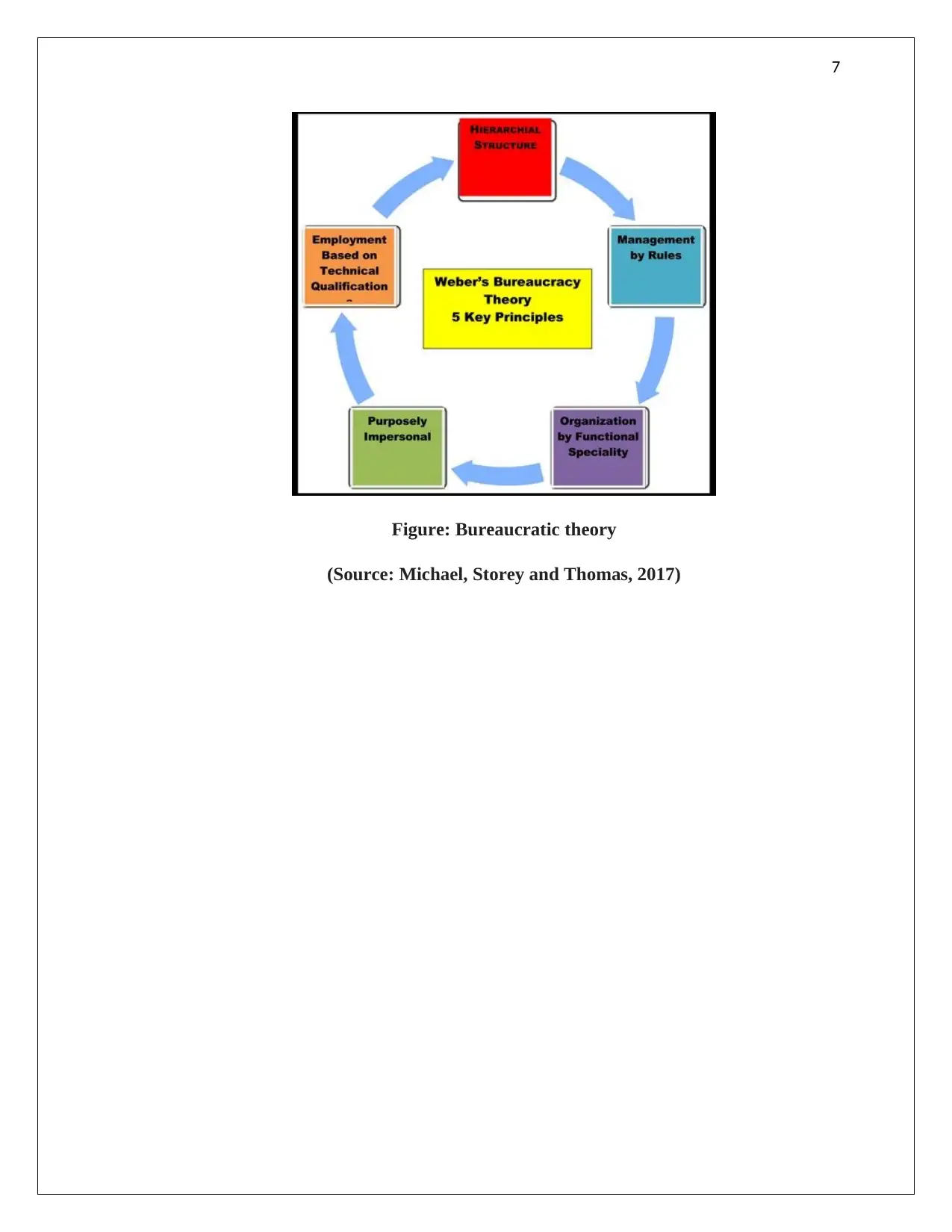
7
Figure: Bureaucratic theory
(Source: Michael, Storey and Thomas, 2017)
Figure: Bureaucratic theory
(Source: Michael, Storey and Thomas, 2017)
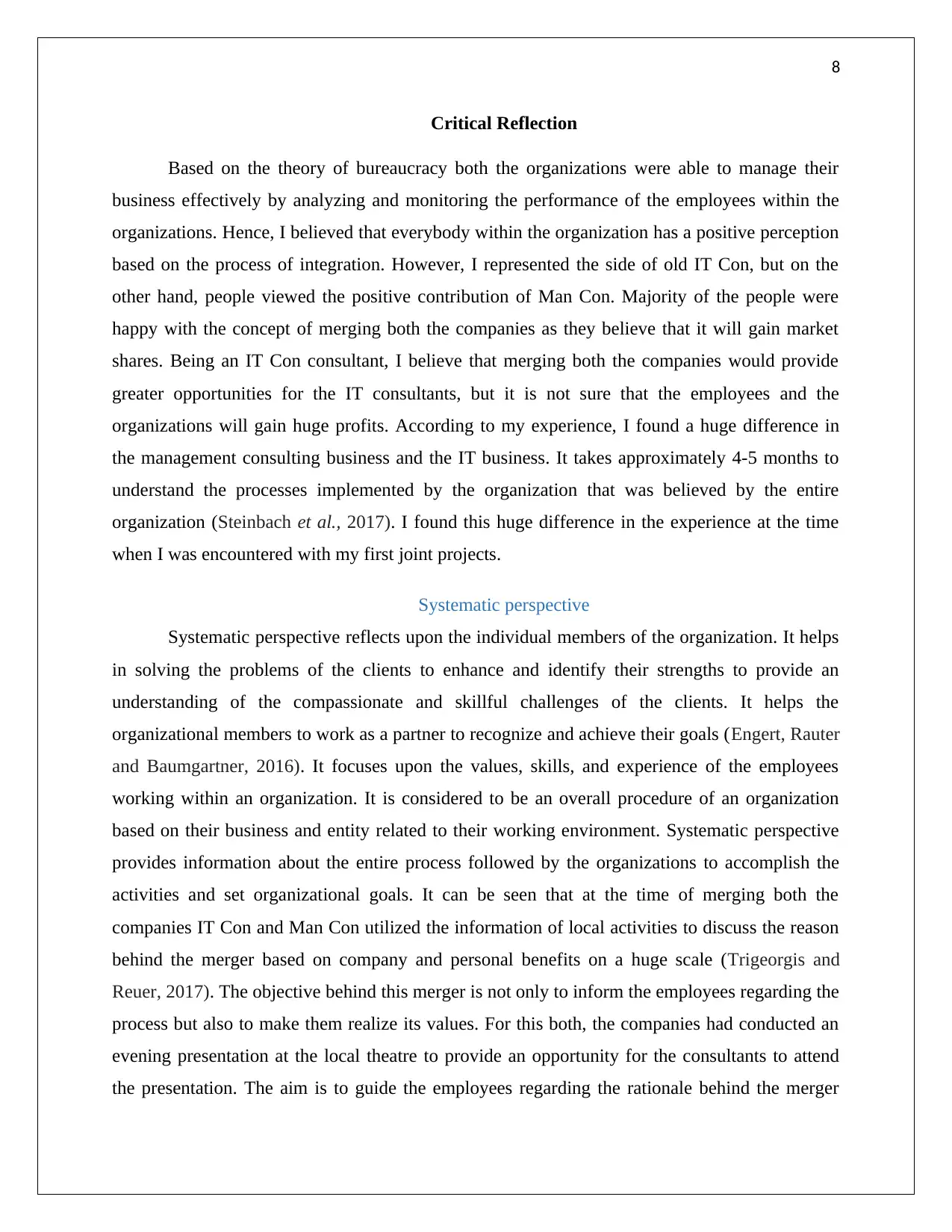
8
Critical Reflection
Based on the theory of bureaucracy both the organizations were able to manage their
business effectively by analyzing and monitoring the performance of the employees within the
organizations. Hence, I believed that everybody within the organization has a positive perception
based on the process of integration. However, I represented the side of old IT Con, but on the
other hand, people viewed the positive contribution of Man Con. Majority of the people were
happy with the concept of merging both the companies as they believe that it will gain market
shares. Being an IT Con consultant, I believe that merging both the companies would provide
greater opportunities for the IT consultants, but it is not sure that the employees and the
organizations will gain huge profits. According to my experience, I found a huge difference in
the management consulting business and the IT business. It takes approximately 4-5 months to
understand the processes implemented by the organization that was believed by the entire
organization (Steinbach et al., 2017). I found this huge difference in the experience at the time
when I was encountered with my first joint projects.
Systematic perspective
Systematic perspective reflects upon the individual members of the organization. It helps
in solving the problems of the clients to enhance and identify their strengths to provide an
understanding of the compassionate and skillful challenges of the clients. It helps the
organizational members to work as a partner to recognize and achieve their goals (Engert, Rauter
and Baumgartner, 2016). It focuses upon the values, skills, and experience of the employees
working within an organization. It is considered to be an overall procedure of an organization
based on their business and entity related to their working environment. Systematic perspective
provides information about the entire process followed by the organizations to accomplish the
activities and set organizational goals. It can be seen that at the time of merging both the
companies IT Con and Man Con utilized the information of local activities to discuss the reason
behind the merger based on company and personal benefits on a huge scale (Trigeorgis and
Reuer, 2017). The objective behind this merger is not only to inform the employees regarding the
process but also to make them realize its values. For this both, the companies had conducted an
evening presentation at the local theatre to provide an opportunity for the consultants to attend
the presentation. The aim is to guide the employees regarding the rationale behind the merger
Critical Reflection
Based on the theory of bureaucracy both the organizations were able to manage their
business effectively by analyzing and monitoring the performance of the employees within the
organizations. Hence, I believed that everybody within the organization has a positive perception
based on the process of integration. However, I represented the side of old IT Con, but on the
other hand, people viewed the positive contribution of Man Con. Majority of the people were
happy with the concept of merging both the companies as they believe that it will gain market
shares. Being an IT Con consultant, I believe that merging both the companies would provide
greater opportunities for the IT consultants, but it is not sure that the employees and the
organizations will gain huge profits. According to my experience, I found a huge difference in
the management consulting business and the IT business. It takes approximately 4-5 months to
understand the processes implemented by the organization that was believed by the entire
organization (Steinbach et al., 2017). I found this huge difference in the experience at the time
when I was encountered with my first joint projects.
Systematic perspective
Systematic perspective reflects upon the individual members of the organization. It helps
in solving the problems of the clients to enhance and identify their strengths to provide an
understanding of the compassionate and skillful challenges of the clients. It helps the
organizational members to work as a partner to recognize and achieve their goals (Engert, Rauter
and Baumgartner, 2016). It focuses upon the values, skills, and experience of the employees
working within an organization. It is considered to be an overall procedure of an organization
based on their business and entity related to their working environment. Systematic perspective
provides information about the entire process followed by the organizations to accomplish the
activities and set organizational goals. It can be seen that at the time of merging both the
companies IT Con and Man Con utilized the information of local activities to discuss the reason
behind the merger based on company and personal benefits on a huge scale (Trigeorgis and
Reuer, 2017). The objective behind this merger is not only to inform the employees regarding the
process but also to make them realize its values. For this both, the companies had conducted an
evening presentation at the local theatre to provide an opportunity for the consultants to attend
the presentation. The aim is to guide the employees regarding the rationale behind the merger
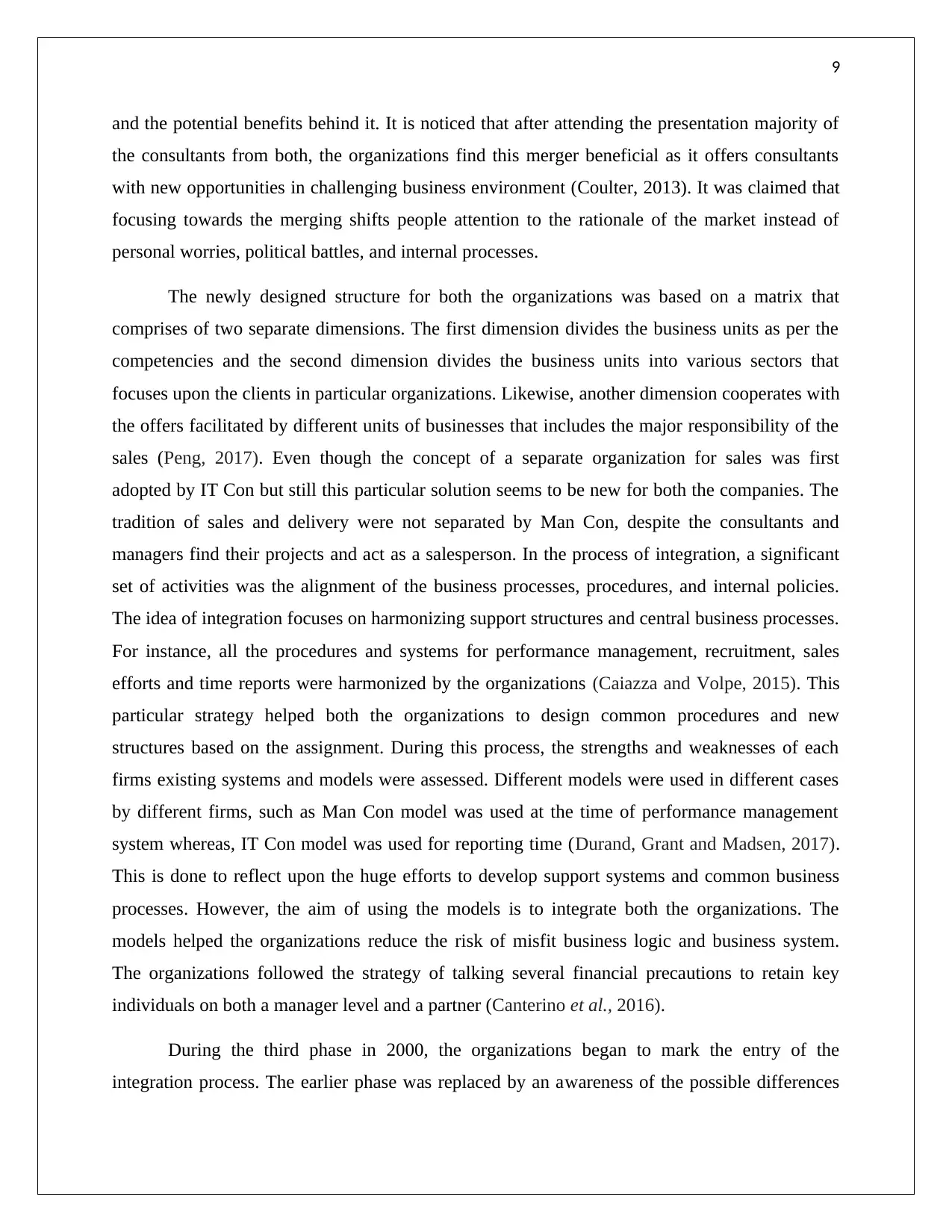
9
and the potential benefits behind it. It is noticed that after attending the presentation majority of
the consultants from both, the organizations find this merger beneficial as it offers consultants
with new opportunities in challenging business environment (Coulter, 2013). It was claimed that
focusing towards the merging shifts people attention to the rationale of the market instead of
personal worries, political battles, and internal processes.
The newly designed structure for both the organizations was based on a matrix that
comprises of two separate dimensions. The first dimension divides the business units as per the
competencies and the second dimension divides the business units into various sectors that
focuses upon the clients in particular organizations. Likewise, another dimension cooperates with
the offers facilitated by different units of businesses that includes the major responsibility of the
sales (Peng, 2017). Even though the concept of a separate organization for sales was first
adopted by IT Con but still this particular solution seems to be new for both the companies. The
tradition of sales and delivery were not separated by Man Con, despite the consultants and
managers find their projects and act as a salesperson. In the process of integration, a significant
set of activities was the alignment of the business processes, procedures, and internal policies.
The idea of integration focuses on harmonizing support structures and central business processes.
For instance, all the procedures and systems for performance management, recruitment, sales
efforts and time reports were harmonized by the organizations (Caiazza and Volpe, 2015). This
particular strategy helped both the organizations to design common procedures and new
structures based on the assignment. During this process, the strengths and weaknesses of each
firms existing systems and models were assessed. Different models were used in different cases
by different firms, such as Man Con model was used at the time of performance management
system whereas, IT Con model was used for reporting time (Durand, Grant and Madsen, 2017).
This is done to reflect upon the huge efforts to develop support systems and common business
processes. However, the aim of using the models is to integrate both the organizations. The
models helped the organizations reduce the risk of misfit business logic and business system.
The organizations followed the strategy of talking several financial precautions to retain key
individuals on both a manager level and a partner (Canterino et al., 2016).
During the third phase in 2000, the organizations began to mark the entry of the
integration process. The earlier phase was replaced by an awareness of the possible differences
and the potential benefits behind it. It is noticed that after attending the presentation majority of
the consultants from both, the organizations find this merger beneficial as it offers consultants
with new opportunities in challenging business environment (Coulter, 2013). It was claimed that
focusing towards the merging shifts people attention to the rationale of the market instead of
personal worries, political battles, and internal processes.
The newly designed structure for both the organizations was based on a matrix that
comprises of two separate dimensions. The first dimension divides the business units as per the
competencies and the second dimension divides the business units into various sectors that
focuses upon the clients in particular organizations. Likewise, another dimension cooperates with
the offers facilitated by different units of businesses that includes the major responsibility of the
sales (Peng, 2017). Even though the concept of a separate organization for sales was first
adopted by IT Con but still this particular solution seems to be new for both the companies. The
tradition of sales and delivery were not separated by Man Con, despite the consultants and
managers find their projects and act as a salesperson. In the process of integration, a significant
set of activities was the alignment of the business processes, procedures, and internal policies.
The idea of integration focuses on harmonizing support structures and central business processes.
For instance, all the procedures and systems for performance management, recruitment, sales
efforts and time reports were harmonized by the organizations (Caiazza and Volpe, 2015). This
particular strategy helped both the organizations to design common procedures and new
structures based on the assignment. During this process, the strengths and weaknesses of each
firms existing systems and models were assessed. Different models were used in different cases
by different firms, such as Man Con model was used at the time of performance management
system whereas, IT Con model was used for reporting time (Durand, Grant and Madsen, 2017).
This is done to reflect upon the huge efforts to develop support systems and common business
processes. However, the aim of using the models is to integrate both the organizations. The
models helped the organizations reduce the risk of misfit business logic and business system.
The organizations followed the strategy of talking several financial precautions to retain key
individuals on both a manager level and a partner (Canterino et al., 2016).
During the third phase in 2000, the organizations began to mark the entry of the
integration process. The earlier phase was replaced by an awareness of the possible differences
Secure Best Marks with AI Grader
Need help grading? Try our AI Grader for instant feedback on your assignments.
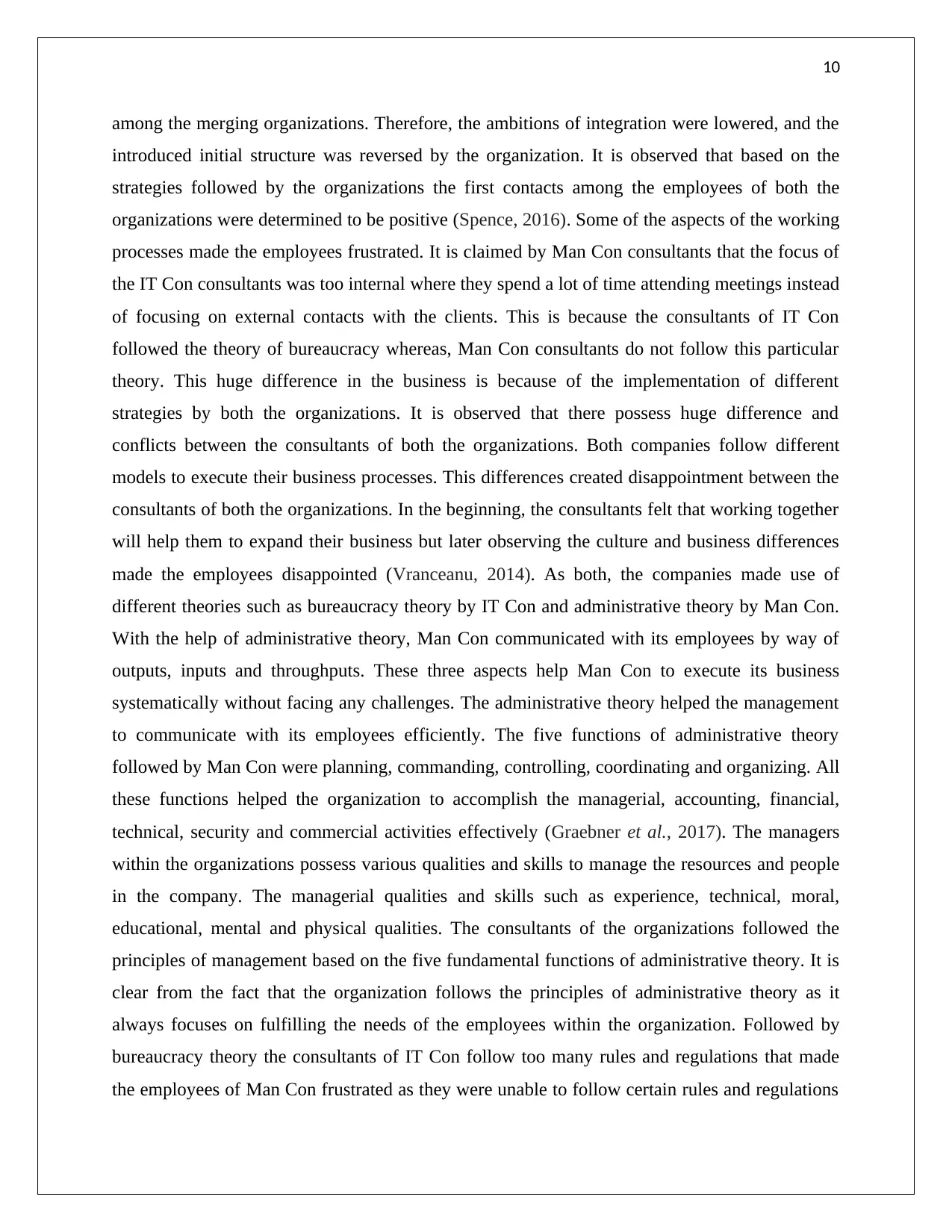
10
among the merging organizations. Therefore, the ambitions of integration were lowered, and the
introduced initial structure was reversed by the organization. It is observed that based on the
strategies followed by the organizations the first contacts among the employees of both the
organizations were determined to be positive (Spence, 2016). Some of the aspects of the working
processes made the employees frustrated. It is claimed by Man Con consultants that the focus of
the IT Con consultants was too internal where they spend a lot of time attending meetings instead
of focusing on external contacts with the clients. This is because the consultants of IT Con
followed the theory of bureaucracy whereas, Man Con consultants do not follow this particular
theory. This huge difference in the business is because of the implementation of different
strategies by both the organizations. It is observed that there possess huge difference and
conflicts between the consultants of both the organizations. Both companies follow different
models to execute their business processes. This differences created disappointment between the
consultants of both the organizations. In the beginning, the consultants felt that working together
will help them to expand their business but later observing the culture and business differences
made the employees disappointed (Vranceanu, 2014). As both, the companies made use of
different theories such as bureaucracy theory by IT Con and administrative theory by Man Con.
With the help of administrative theory, Man Con communicated with its employees by way of
outputs, inputs and throughputs. These three aspects help Man Con to execute its business
systematically without facing any challenges. The administrative theory helped the management
to communicate with its employees efficiently. The five functions of administrative theory
followed by Man Con were planning, commanding, controlling, coordinating and organizing. All
these functions helped the organization to accomplish the managerial, accounting, financial,
technical, security and commercial activities effectively (Graebner et al., 2017). The managers
within the organizations possess various qualities and skills to manage the resources and people
in the company. The managerial qualities and skills such as experience, technical, moral,
educational, mental and physical qualities. The consultants of the organizations followed the
principles of management based on the five fundamental functions of administrative theory. It is
clear from the fact that the organization follows the principles of administrative theory as it
always focuses on fulfilling the needs of the employees within the organization. Followed by
bureaucracy theory the consultants of IT Con follow too many rules and regulations that made
the employees of Man Con frustrated as they were unable to follow certain rules and regulations
among the merging organizations. Therefore, the ambitions of integration were lowered, and the
introduced initial structure was reversed by the organization. It is observed that based on the
strategies followed by the organizations the first contacts among the employees of both the
organizations were determined to be positive (Spence, 2016). Some of the aspects of the working
processes made the employees frustrated. It is claimed by Man Con consultants that the focus of
the IT Con consultants was too internal where they spend a lot of time attending meetings instead
of focusing on external contacts with the clients. This is because the consultants of IT Con
followed the theory of bureaucracy whereas, Man Con consultants do not follow this particular
theory. This huge difference in the business is because of the implementation of different
strategies by both the organizations. It is observed that there possess huge difference and
conflicts between the consultants of both the organizations. Both companies follow different
models to execute their business processes. This differences created disappointment between the
consultants of both the organizations. In the beginning, the consultants felt that working together
will help them to expand their business but later observing the culture and business differences
made the employees disappointed (Vranceanu, 2014). As both, the companies made use of
different theories such as bureaucracy theory by IT Con and administrative theory by Man Con.
With the help of administrative theory, Man Con communicated with its employees by way of
outputs, inputs and throughputs. These three aspects help Man Con to execute its business
systematically without facing any challenges. The administrative theory helped the management
to communicate with its employees efficiently. The five functions of administrative theory
followed by Man Con were planning, commanding, controlling, coordinating and organizing. All
these functions helped the organization to accomplish the managerial, accounting, financial,
technical, security and commercial activities effectively (Graebner et al., 2017). The managers
within the organizations possess various qualities and skills to manage the resources and people
in the company. The managerial qualities and skills such as experience, technical, moral,
educational, mental and physical qualities. The consultants of the organizations followed the
principles of management based on the five fundamental functions of administrative theory. It is
clear from the fact that the organization follows the principles of administrative theory as it
always focuses on fulfilling the needs of the employees within the organization. Followed by
bureaucracy theory the consultants of IT Con follow too many rules and regulations that made
the employees of Man Con frustrated as they were unable to follow certain rules and regulations
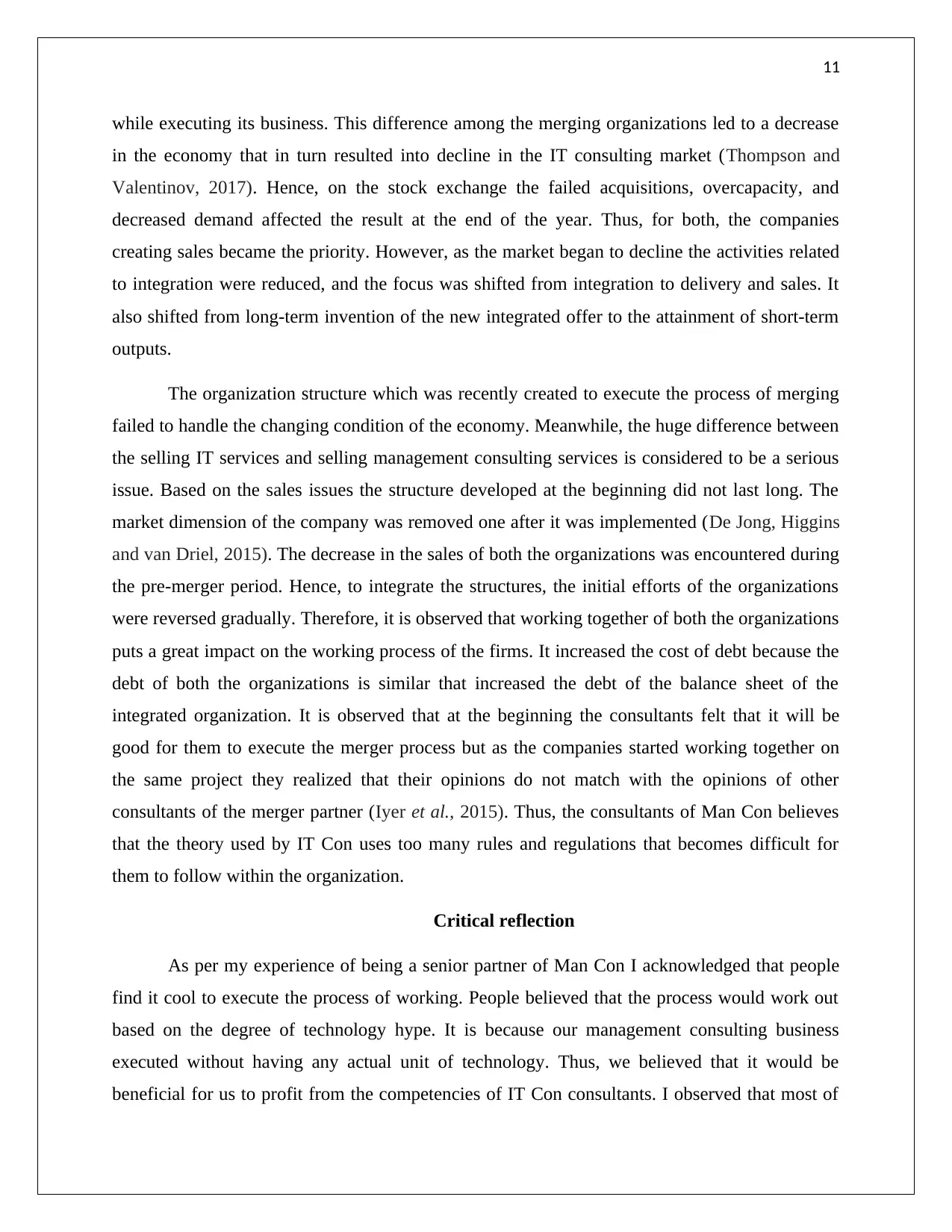
11
while executing its business. This difference among the merging organizations led to a decrease
in the economy that in turn resulted into decline in the IT consulting market (Thompson and
Valentinov, 2017). Hence, on the stock exchange the failed acquisitions, overcapacity, and
decreased demand affected the result at the end of the year. Thus, for both, the companies
creating sales became the priority. However, as the market began to decline the activities related
to integration were reduced, and the focus was shifted from integration to delivery and sales. It
also shifted from long-term invention of the new integrated offer to the attainment of short-term
outputs.
The organization structure which was recently created to execute the process of merging
failed to handle the changing condition of the economy. Meanwhile, the huge difference between
the selling IT services and selling management consulting services is considered to be a serious
issue. Based on the sales issues the structure developed at the beginning did not last long. The
market dimension of the company was removed one after it was implemented (De Jong, Higgins
and van Driel, 2015). The decrease in the sales of both the organizations was encountered during
the pre-merger period. Hence, to integrate the structures, the initial efforts of the organizations
were reversed gradually. Therefore, it is observed that working together of both the organizations
puts a great impact on the working process of the firms. It increased the cost of debt because the
debt of both the organizations is similar that increased the debt of the balance sheet of the
integrated organization. It is observed that at the beginning the consultants felt that it will be
good for them to execute the merger process but as the companies started working together on
the same project they realized that their opinions do not match with the opinions of other
consultants of the merger partner (Iyer et al., 2015). Thus, the consultants of Man Con believes
that the theory used by IT Con uses too many rules and regulations that becomes difficult for
them to follow within the organization.
Critical reflection
As per my experience of being a senior partner of Man Con I acknowledged that people
find it cool to execute the process of working. People believed that the process would work out
based on the degree of technology hype. It is because our management consulting business
executed without having any actual unit of technology. Thus, we believed that it would be
beneficial for us to profit from the competencies of IT Con consultants. I observed that most of
while executing its business. This difference among the merging organizations led to a decrease
in the economy that in turn resulted into decline in the IT consulting market (Thompson and
Valentinov, 2017). Hence, on the stock exchange the failed acquisitions, overcapacity, and
decreased demand affected the result at the end of the year. Thus, for both, the companies
creating sales became the priority. However, as the market began to decline the activities related
to integration were reduced, and the focus was shifted from integration to delivery and sales. It
also shifted from long-term invention of the new integrated offer to the attainment of short-term
outputs.
The organization structure which was recently created to execute the process of merging
failed to handle the changing condition of the economy. Meanwhile, the huge difference between
the selling IT services and selling management consulting services is considered to be a serious
issue. Based on the sales issues the structure developed at the beginning did not last long. The
market dimension of the company was removed one after it was implemented (De Jong, Higgins
and van Driel, 2015). The decrease in the sales of both the organizations was encountered during
the pre-merger period. Hence, to integrate the structures, the initial efforts of the organizations
were reversed gradually. Therefore, it is observed that working together of both the organizations
puts a great impact on the working process of the firms. It increased the cost of debt because the
debt of both the organizations is similar that increased the debt of the balance sheet of the
integrated organization. It is observed that at the beginning the consultants felt that it will be
good for them to execute the merger process but as the companies started working together on
the same project they realized that their opinions do not match with the opinions of other
consultants of the merger partner (Iyer et al., 2015). Thus, the consultants of Man Con believes
that the theory used by IT Con uses too many rules and regulations that becomes difficult for
them to follow within the organization.
Critical reflection
As per my experience of being a senior partner of Man Con I acknowledged that people
find it cool to execute the process of working. People believed that the process would work out
based on the degree of technology hype. It is because our management consulting business
executed without having any actual unit of technology. Thus, we believed that it would be
beneficial for us to profit from the competencies of IT Con consultants. I observed that most of
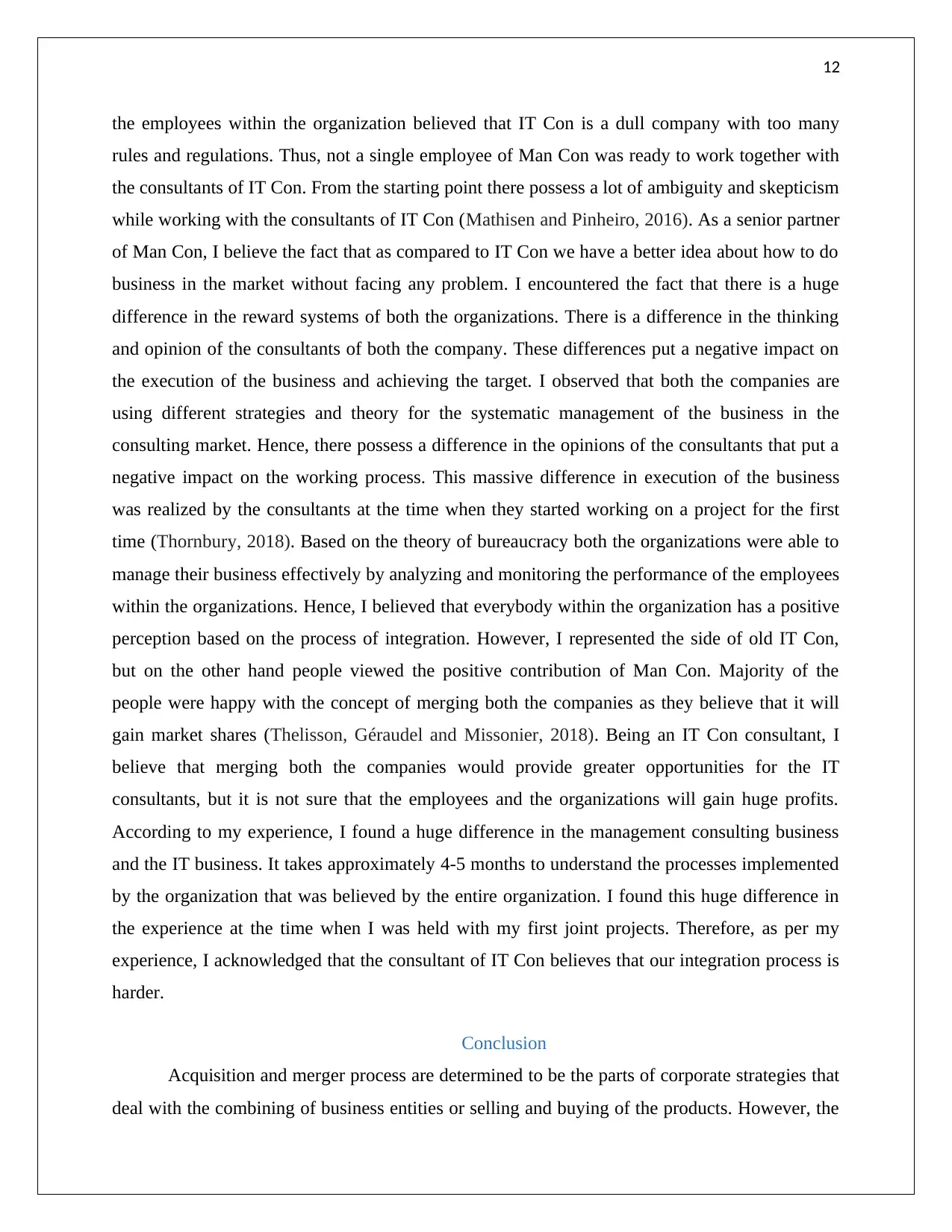
12
the employees within the organization believed that IT Con is a dull company with too many
rules and regulations. Thus, not a single employee of Man Con was ready to work together with
the consultants of IT Con. From the starting point there possess a lot of ambiguity and skepticism
while working with the consultants of IT Con (Mathisen and Pinheiro, 2016). As a senior partner
of Man Con, I believe the fact that as compared to IT Con we have a better idea about how to do
business in the market without facing any problem. I encountered the fact that there is a huge
difference in the reward systems of both the organizations. There is a difference in the thinking
and opinion of the consultants of both the company. These differences put a negative impact on
the execution of the business and achieving the target. I observed that both the companies are
using different strategies and theory for the systematic management of the business in the
consulting market. Hence, there possess a difference in the opinions of the consultants that put a
negative impact on the working process. This massive difference in execution of the business
was realized by the consultants at the time when they started working on a project for the first
time (Thornbury, 2018). Based on the theory of bureaucracy both the organizations were able to
manage their business effectively by analyzing and monitoring the performance of the employees
within the organizations. Hence, I believed that everybody within the organization has a positive
perception based on the process of integration. However, I represented the side of old IT Con,
but on the other hand people viewed the positive contribution of Man Con. Majority of the
people were happy with the concept of merging both the companies as they believe that it will
gain market shares (Thelisson, Géraudel and Missonier, 2018). Being an IT Con consultant, I
believe that merging both the companies would provide greater opportunities for the IT
consultants, but it is not sure that the employees and the organizations will gain huge profits.
According to my experience, I found a huge difference in the management consulting business
and the IT business. It takes approximately 4-5 months to understand the processes implemented
by the organization that was believed by the entire organization. I found this huge difference in
the experience at the time when I was held with my first joint projects. Therefore, as per my
experience, I acknowledged that the consultant of IT Con believes that our integration process is
harder.
Conclusion
Acquisition and merger process are determined to be the parts of corporate strategies that
deal with the combining of business entities or selling and buying of the products. However, the
the employees within the organization believed that IT Con is a dull company with too many
rules and regulations. Thus, not a single employee of Man Con was ready to work together with
the consultants of IT Con. From the starting point there possess a lot of ambiguity and skepticism
while working with the consultants of IT Con (Mathisen and Pinheiro, 2016). As a senior partner
of Man Con, I believe the fact that as compared to IT Con we have a better idea about how to do
business in the market without facing any problem. I encountered the fact that there is a huge
difference in the reward systems of both the organizations. There is a difference in the thinking
and opinion of the consultants of both the company. These differences put a negative impact on
the execution of the business and achieving the target. I observed that both the companies are
using different strategies and theory for the systematic management of the business in the
consulting market. Hence, there possess a difference in the opinions of the consultants that put a
negative impact on the working process. This massive difference in execution of the business
was realized by the consultants at the time when they started working on a project for the first
time (Thornbury, 2018). Based on the theory of bureaucracy both the organizations were able to
manage their business effectively by analyzing and monitoring the performance of the employees
within the organizations. Hence, I believed that everybody within the organization has a positive
perception based on the process of integration. However, I represented the side of old IT Con,
but on the other hand people viewed the positive contribution of Man Con. Majority of the
people were happy with the concept of merging both the companies as they believe that it will
gain market shares (Thelisson, Géraudel and Missonier, 2018). Being an IT Con consultant, I
believe that merging both the companies would provide greater opportunities for the IT
consultants, but it is not sure that the employees and the organizations will gain huge profits.
According to my experience, I found a huge difference in the management consulting business
and the IT business. It takes approximately 4-5 months to understand the processes implemented
by the organization that was believed by the entire organization. I found this huge difference in
the experience at the time when I was held with my first joint projects. Therefore, as per my
experience, I acknowledged that the consultant of IT Con believes that our integration process is
harder.
Conclusion
Acquisition and merger process are determined to be the parts of corporate strategies that
deal with the combining of business entities or selling and buying of the products. However, the
Paraphrase This Document
Need a fresh take? Get an instant paraphrase of this document with our AI Paraphraser
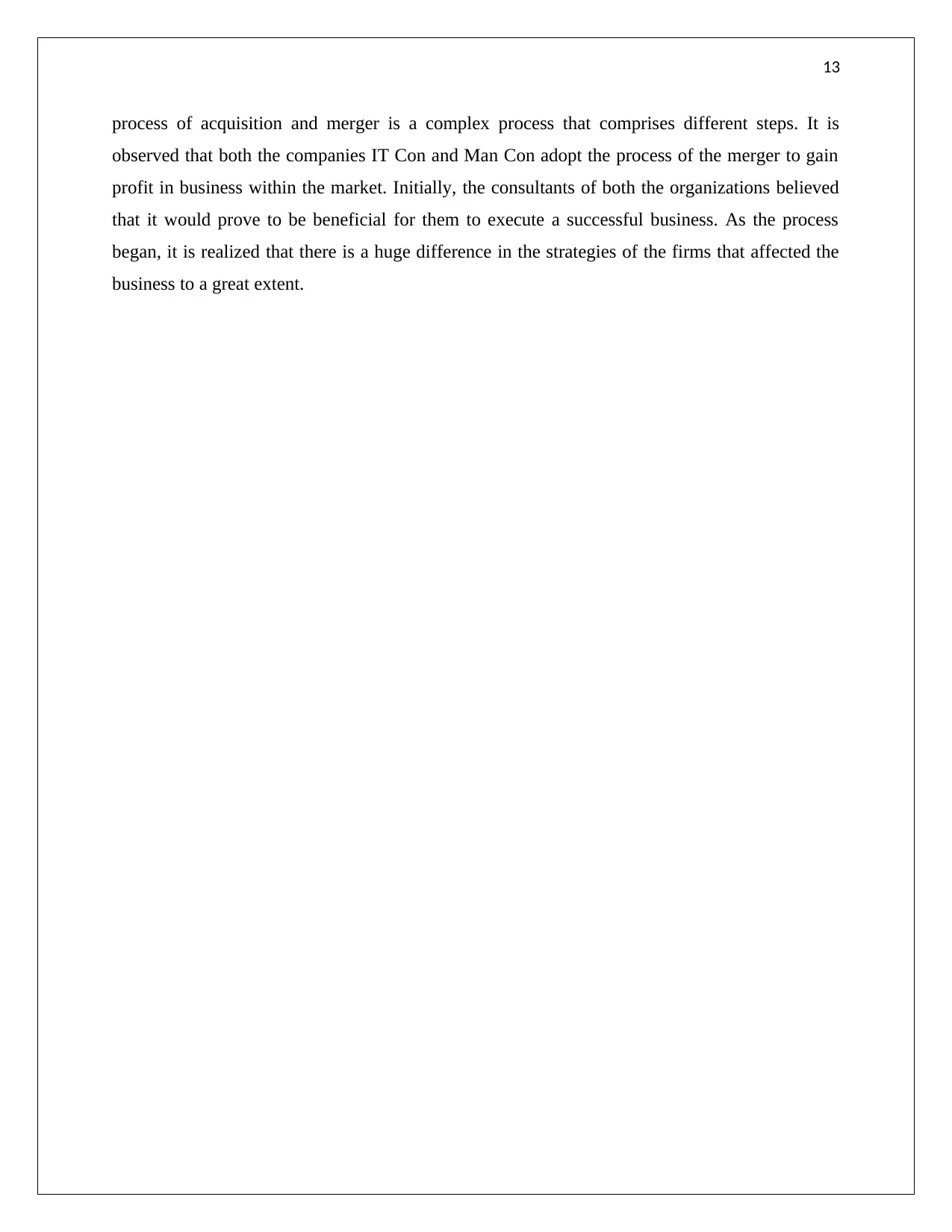
13
process of acquisition and merger is a complex process that comprises different steps. It is
observed that both the companies IT Con and Man Con adopt the process of the merger to gain
profit in business within the market. Initially, the consultants of both the organizations believed
that it would prove to be beneficial for them to execute a successful business. As the process
began, it is realized that there is a huge difference in the strategies of the firms that affected the
business to a great extent.
process of acquisition and merger is a complex process that comprises different steps. It is
observed that both the companies IT Con and Man Con adopt the process of the merger to gain
profit in business within the market. Initially, the consultants of both the organizations believed
that it would prove to be beneficial for them to execute a successful business. As the process
began, it is realized that there is a huge difference in the strategies of the firms that affected the
business to a great extent.
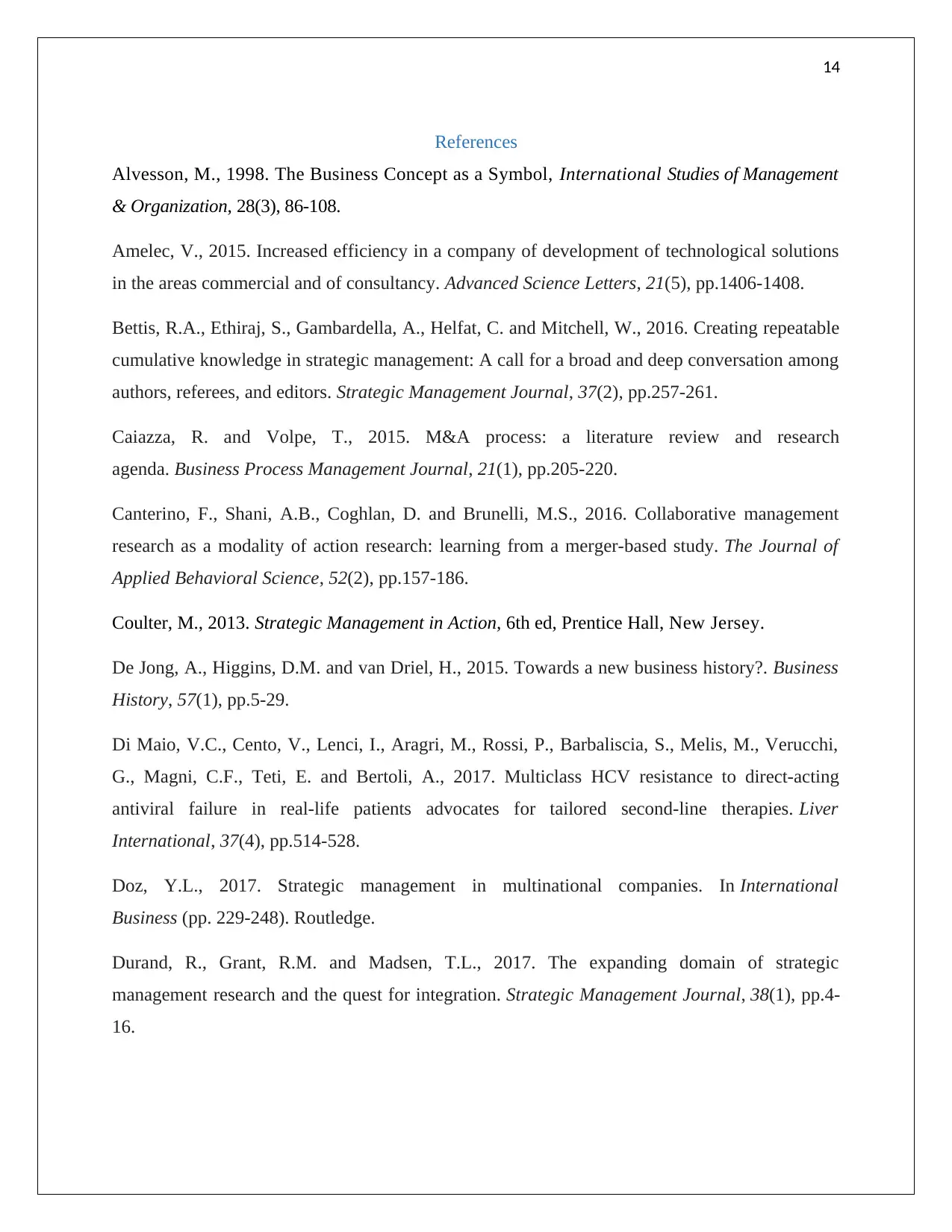
14
References
Alvesson, M., 1998. The Business Concept as a Symbol, International Studies of Management
& Organization, 28(3), 86-108.
Amelec, V., 2015. Increased efficiency in a company of development of technological solutions
in the areas commercial and of consultancy. Advanced Science Letters, 21(5), pp.1406-1408.
Bettis, R.A., Ethiraj, S., Gambardella, A., Helfat, C. and Mitchell, W., 2016. Creating repeatable
cumulative knowledge in strategic management: A call for a broad and deep conversation among
authors, referees, and editors. Strategic Management Journal, 37(2), pp.257-261.
Caiazza, R. and Volpe, T., 2015. M&A process: a literature review and research
agenda. Business Process Management Journal, 21(1), pp.205-220.
Canterino, F., Shani, A.B., Coghlan, D. and Brunelli, M.S., 2016. Collaborative management
research as a modality of action research: learning from a merger-based study. The Journal of
Applied Behavioral Science, 52(2), pp.157-186.
Coulter, M., 2013. Strategic Management in Action, 6th ed, Prentice Hall, New Jersey.
De Jong, A., Higgins, D.M. and van Driel, H., 2015. Towards a new business history?. Business
History, 57(1), pp.5-29.
Di Maio, V.C., Cento, V., Lenci, I., Aragri, M., Rossi, P., Barbaliscia, S., Melis, M., Verucchi,
G., Magni, C.F., Teti, E. and Bertoli, A., 2017. Multiclass HCV resistance to direct‐acting
antiviral failure in real‐life patients advocates for tailored second‐line therapies. Liver
International, 37(4), pp.514-528.
Doz, Y.L., 2017. Strategic management in multinational companies. In International
Business (pp. 229-248). Routledge.
Durand, R., Grant, R.M. and Madsen, T.L., 2017. The expanding domain of strategic
management research and the quest for integration. Strategic Management Journal, 38(1), pp.4-
16.
References
Alvesson, M., 1998. The Business Concept as a Symbol, International Studies of Management
& Organization, 28(3), 86-108.
Amelec, V., 2015. Increased efficiency in a company of development of technological solutions
in the areas commercial and of consultancy. Advanced Science Letters, 21(5), pp.1406-1408.
Bettis, R.A., Ethiraj, S., Gambardella, A., Helfat, C. and Mitchell, W., 2016. Creating repeatable
cumulative knowledge in strategic management: A call for a broad and deep conversation among
authors, referees, and editors. Strategic Management Journal, 37(2), pp.257-261.
Caiazza, R. and Volpe, T., 2015. M&A process: a literature review and research
agenda. Business Process Management Journal, 21(1), pp.205-220.
Canterino, F., Shani, A.B., Coghlan, D. and Brunelli, M.S., 2016. Collaborative management
research as a modality of action research: learning from a merger-based study. The Journal of
Applied Behavioral Science, 52(2), pp.157-186.
Coulter, M., 2013. Strategic Management in Action, 6th ed, Prentice Hall, New Jersey.
De Jong, A., Higgins, D.M. and van Driel, H., 2015. Towards a new business history?. Business
History, 57(1), pp.5-29.
Di Maio, V.C., Cento, V., Lenci, I., Aragri, M., Rossi, P., Barbaliscia, S., Melis, M., Verucchi,
G., Magni, C.F., Teti, E. and Bertoli, A., 2017. Multiclass HCV resistance to direct‐acting
antiviral failure in real‐life patients advocates for tailored second‐line therapies. Liver
International, 37(4), pp.514-528.
Doz, Y.L., 2017. Strategic management in multinational companies. In International
Business (pp. 229-248). Routledge.
Durand, R., Grant, R.M. and Madsen, T.L., 2017. The expanding domain of strategic
management research and the quest for integration. Strategic Management Journal, 38(1), pp.4-
16.
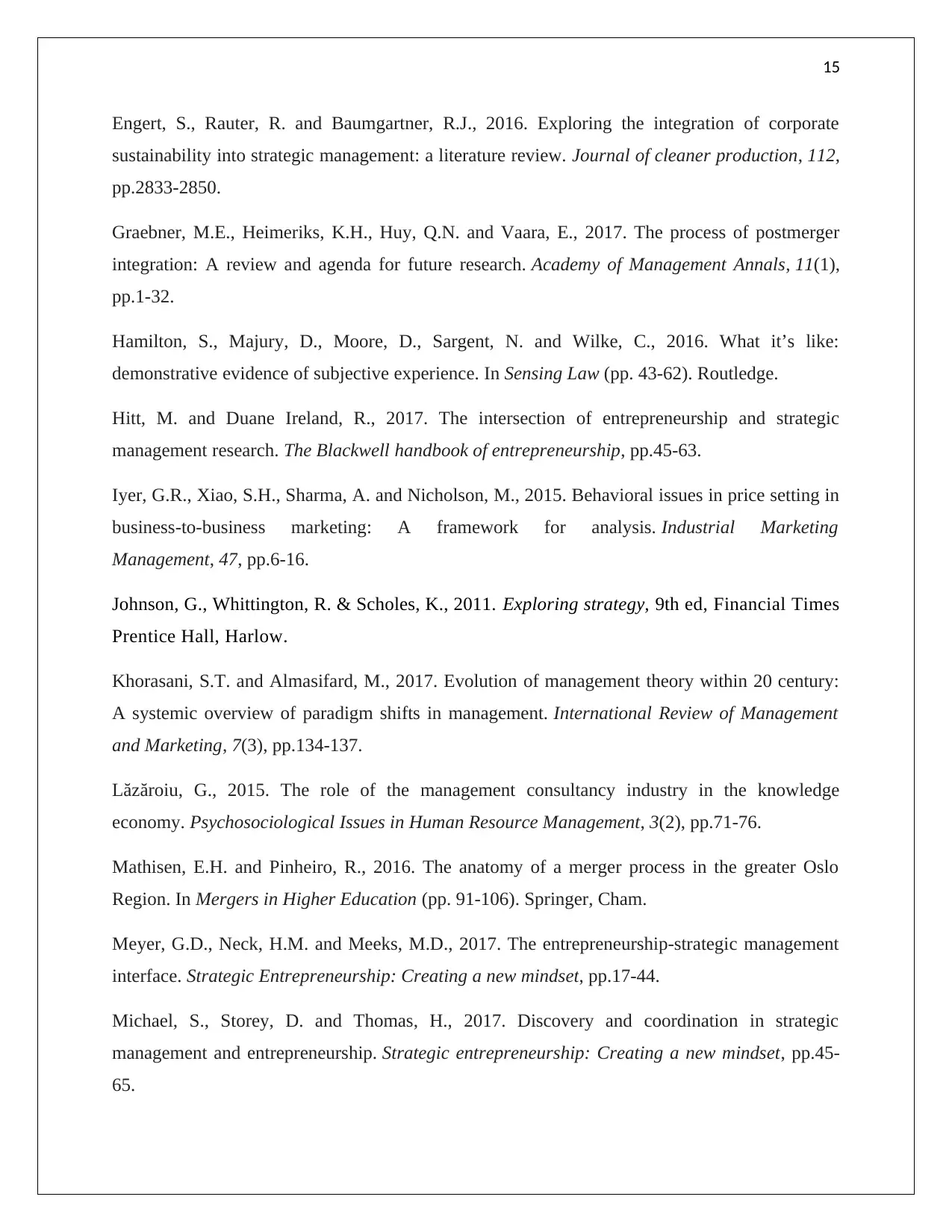
15
Engert, S., Rauter, R. and Baumgartner, R.J., 2016. Exploring the integration of corporate
sustainability into strategic management: a literature review. Journal of cleaner production, 112,
pp.2833-2850.
Graebner, M.E., Heimeriks, K.H., Huy, Q.N. and Vaara, E., 2017. The process of postmerger
integration: A review and agenda for future research. Academy of Management Annals, 11(1),
pp.1-32.
Hamilton, S., Majury, D., Moore, D., Sargent, N. and Wilke, C., 2016. What it’s like:
demonstrative evidence of subjective experience. In Sensing Law (pp. 43-62). Routledge.
Hitt, M. and Duane Ireland, R., 2017. The intersection of entrepreneurship and strategic
management research. The Blackwell handbook of entrepreneurship, pp.45-63.
Iyer, G.R., Xiao, S.H., Sharma, A. and Nicholson, M., 2015. Behavioral issues in price setting in
business-to-business marketing: A framework for analysis. Industrial Marketing
Management, 47, pp.6-16.
Johnson, G., Whittington, R. & Scholes, K., 2011. Exploring strategy, 9th ed, Financial Times
Prentice Hall, Harlow.
Khorasani, S.T. and Almasifard, M., 2017. Evolution of management theory within 20 century:
A systemic overview of paradigm shifts in management. International Review of Management
and Marketing, 7(3), pp.134-137.
Lăzăroiu, G., 2015. The role of the management consultancy industry in the knowledge
economy. Psychosociological Issues in Human Resource Management, 3(2), pp.71-76.
Mathisen, E.H. and Pinheiro, R., 2016. The anatomy of a merger process in the greater Oslo
Region. In Mergers in Higher Education (pp. 91-106). Springer, Cham.
Meyer, G.D., Neck, H.M. and Meeks, M.D., 2017. The entrepreneurship‐strategic management
interface. Strategic Entrepreneurship: Creating a new mindset, pp.17-44.
Michael, S., Storey, D. and Thomas, H., 2017. Discovery and coordination in strategic
management and entrepreneurship. Strategic entrepreneurship: Creating a new mindset, pp.45-
65.
Engert, S., Rauter, R. and Baumgartner, R.J., 2016. Exploring the integration of corporate
sustainability into strategic management: a literature review. Journal of cleaner production, 112,
pp.2833-2850.
Graebner, M.E., Heimeriks, K.H., Huy, Q.N. and Vaara, E., 2017. The process of postmerger
integration: A review and agenda for future research. Academy of Management Annals, 11(1),
pp.1-32.
Hamilton, S., Majury, D., Moore, D., Sargent, N. and Wilke, C., 2016. What it’s like:
demonstrative evidence of subjective experience. In Sensing Law (pp. 43-62). Routledge.
Hitt, M. and Duane Ireland, R., 2017. The intersection of entrepreneurship and strategic
management research. The Blackwell handbook of entrepreneurship, pp.45-63.
Iyer, G.R., Xiao, S.H., Sharma, A. and Nicholson, M., 2015. Behavioral issues in price setting in
business-to-business marketing: A framework for analysis. Industrial Marketing
Management, 47, pp.6-16.
Johnson, G., Whittington, R. & Scholes, K., 2011. Exploring strategy, 9th ed, Financial Times
Prentice Hall, Harlow.
Khorasani, S.T. and Almasifard, M., 2017. Evolution of management theory within 20 century:
A systemic overview of paradigm shifts in management. International Review of Management
and Marketing, 7(3), pp.134-137.
Lăzăroiu, G., 2015. The role of the management consultancy industry in the knowledge
economy. Psychosociological Issues in Human Resource Management, 3(2), pp.71-76.
Mathisen, E.H. and Pinheiro, R., 2016. The anatomy of a merger process in the greater Oslo
Region. In Mergers in Higher Education (pp. 91-106). Springer, Cham.
Meyer, G.D., Neck, H.M. and Meeks, M.D., 2017. The entrepreneurship‐strategic management
interface. Strategic Entrepreneurship: Creating a new mindset, pp.17-44.
Michael, S., Storey, D. and Thomas, H., 2017. Discovery and coordination in strategic
management and entrepreneurship. Strategic entrepreneurship: Creating a new mindset, pp.45-
65.
Secure Best Marks with AI Grader
Need help grading? Try our AI Grader for instant feedback on your assignments.
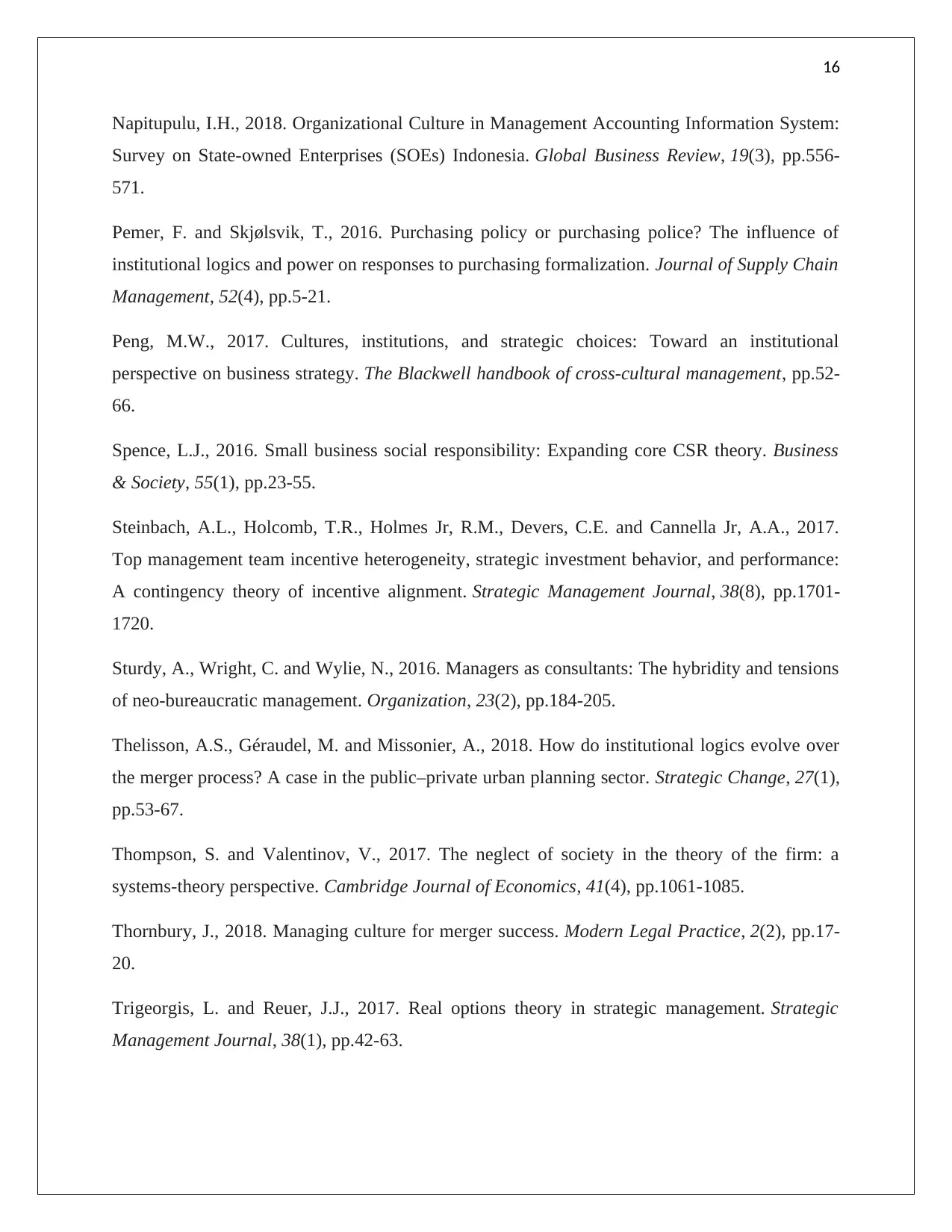
16
Napitupulu, I.H., 2018. Organizational Culture in Management Accounting Information System:
Survey on State-owned Enterprises (SOEs) Indonesia. Global Business Review, 19(3), pp.556-
571.
Pemer, F. and Skjølsvik, T., 2016. Purchasing policy or purchasing police? The influence of
institutional logics and power on responses to purchasing formalization. Journal of Supply Chain
Management, 52(4), pp.5-21.
Peng, M.W., 2017. Cultures, institutions, and strategic choices: Toward an institutional
perspective on business strategy. The Blackwell handbook of cross‐cultural management, pp.52-
66.
Spence, L.J., 2016. Small business social responsibility: Expanding core CSR theory. Business
& Society, 55(1), pp.23-55.
Steinbach, A.L., Holcomb, T.R., Holmes Jr, R.M., Devers, C.E. and Cannella Jr, A.A., 2017.
Top management team incentive heterogeneity, strategic investment behavior, and performance:
A contingency theory of incentive alignment. Strategic Management Journal, 38(8), pp.1701-
1720.
Sturdy, A., Wright, C. and Wylie, N., 2016. Managers as consultants: The hybridity and tensions
of neo-bureaucratic management. Organization, 23(2), pp.184-205.
Thelisson, A.S., Géraudel, M. and Missonier, A., 2018. How do institutional logics evolve over
the merger process? A case in the public–private urban planning sector. Strategic Change, 27(1),
pp.53-67.
Thompson, S. and Valentinov, V., 2017. The neglect of society in the theory of the firm: a
systems-theory perspective. Cambridge Journal of Economics, 41(4), pp.1061-1085.
Thornbury, J., 2018. Managing culture for merger success. Modern Legal Practice, 2(2), pp.17-
20.
Trigeorgis, L. and Reuer, J.J., 2017. Real options theory in strategic management. Strategic
Management Journal, 38(1), pp.42-63.
Napitupulu, I.H., 2018. Organizational Culture in Management Accounting Information System:
Survey on State-owned Enterprises (SOEs) Indonesia. Global Business Review, 19(3), pp.556-
571.
Pemer, F. and Skjølsvik, T., 2016. Purchasing policy or purchasing police? The influence of
institutional logics and power on responses to purchasing formalization. Journal of Supply Chain
Management, 52(4), pp.5-21.
Peng, M.W., 2017. Cultures, institutions, and strategic choices: Toward an institutional
perspective on business strategy. The Blackwell handbook of cross‐cultural management, pp.52-
66.
Spence, L.J., 2016. Small business social responsibility: Expanding core CSR theory. Business
& Society, 55(1), pp.23-55.
Steinbach, A.L., Holcomb, T.R., Holmes Jr, R.M., Devers, C.E. and Cannella Jr, A.A., 2017.
Top management team incentive heterogeneity, strategic investment behavior, and performance:
A contingency theory of incentive alignment. Strategic Management Journal, 38(8), pp.1701-
1720.
Sturdy, A., Wright, C. and Wylie, N., 2016. Managers as consultants: The hybridity and tensions
of neo-bureaucratic management. Organization, 23(2), pp.184-205.
Thelisson, A.S., Géraudel, M. and Missonier, A., 2018. How do institutional logics evolve over
the merger process? A case in the public–private urban planning sector. Strategic Change, 27(1),
pp.53-67.
Thompson, S. and Valentinov, V., 2017. The neglect of society in the theory of the firm: a
systems-theory perspective. Cambridge Journal of Economics, 41(4), pp.1061-1085.
Thornbury, J., 2018. Managing culture for merger success. Modern Legal Practice, 2(2), pp.17-
20.
Trigeorgis, L. and Reuer, J.J., 2017. Real options theory in strategic management. Strategic
Management Journal, 38(1), pp.42-63.
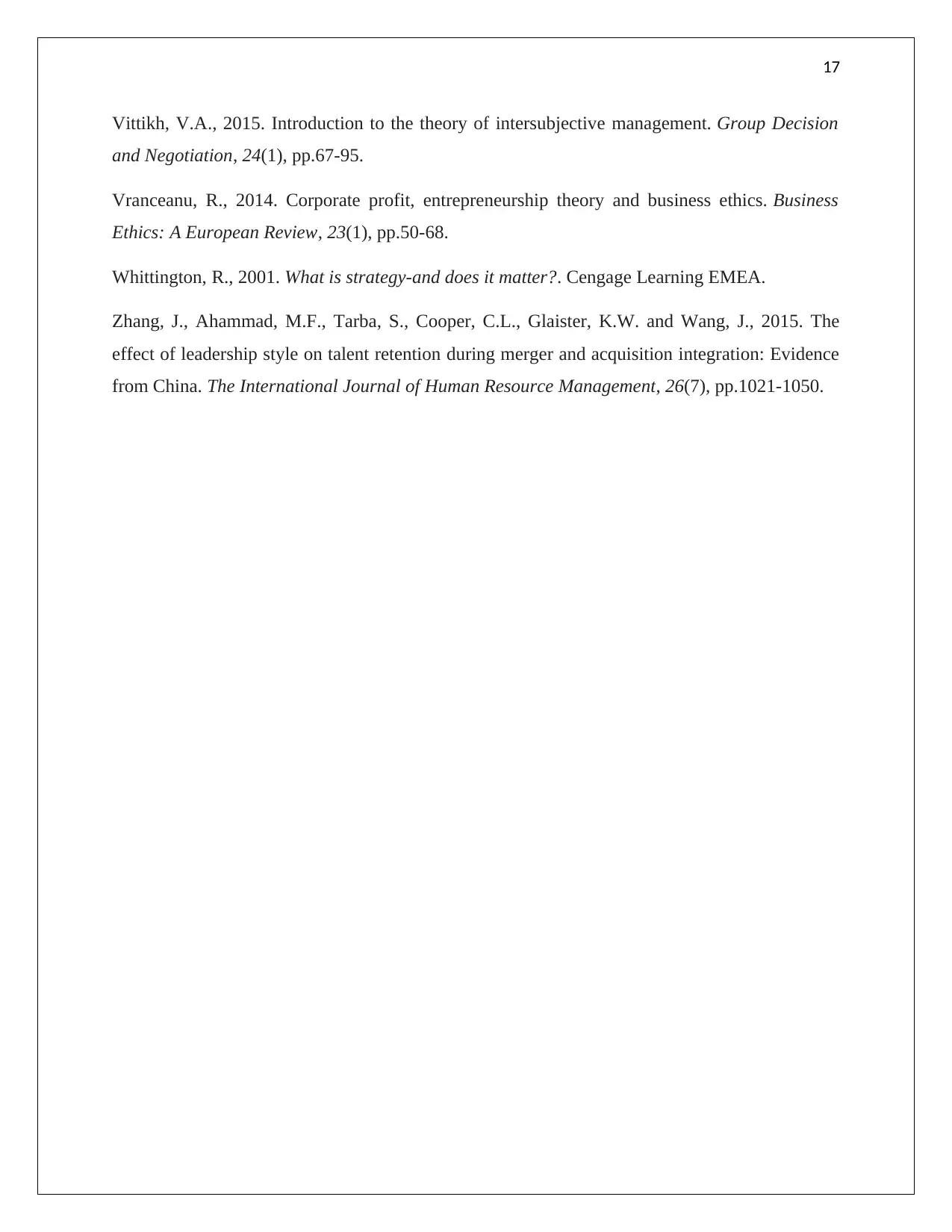
17
Vittikh, V.A., 2015. Introduction to the theory of intersubjective management. Group Decision
and Negotiation, 24(1), pp.67-95.
Vranceanu, R., 2014. Corporate profit, entrepreneurship theory and business ethics. Business
Ethics: A European Review, 23(1), pp.50-68.
Whittington, R., 2001. What is strategy-and does it matter?. Cengage Learning EMEA.
Zhang, J., Ahammad, M.F., Tarba, S., Cooper, C.L., Glaister, K.W. and Wang, J., 2015. The
effect of leadership style on talent retention during merger and acquisition integration: Evidence
from China. The International Journal of Human Resource Management, 26(7), pp.1021-1050.
Vittikh, V.A., 2015. Introduction to the theory of intersubjective management. Group Decision
and Negotiation, 24(1), pp.67-95.
Vranceanu, R., 2014. Corporate profit, entrepreneurship theory and business ethics. Business
Ethics: A European Review, 23(1), pp.50-68.
Whittington, R., 2001. What is strategy-and does it matter?. Cengage Learning EMEA.
Zhang, J., Ahammad, M.F., Tarba, S., Cooper, C.L., Glaister, K.W. and Wang, J., 2015. The
effect of leadership style on talent retention during merger and acquisition integration: Evidence
from China. The International Journal of Human Resource Management, 26(7), pp.1021-1050.
1 out of 18
Related Documents
Your All-in-One AI-Powered Toolkit for Academic Success.
+13062052269
info@desklib.com
Available 24*7 on WhatsApp / Email
![[object Object]](/_next/static/media/star-bottom.7253800d.svg)
Unlock your academic potential
© 2024 | Zucol Services PVT LTD | All rights reserved.





